Vol. 72, No. 11 (2023)
2023-06-05
INVITED REVIEW
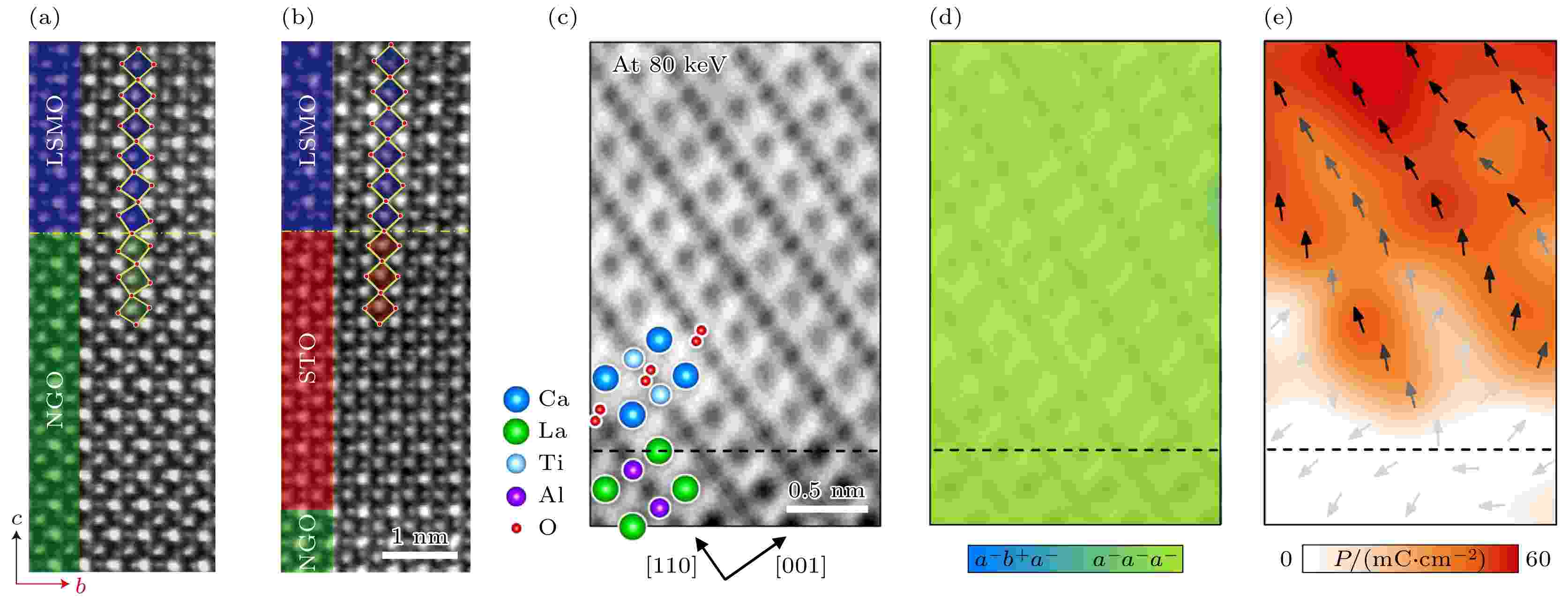
INVITED REVIEW
2023, 72 (11): 116801.
doi:10.7498/aps.72.20230045
Abstract +
Structure design and performance regulation of functional materials are the cutting-edge hot topic in the field of materials science and condensed mater physics. Constructing hierarchical structures with functional units recently has become a new paradigm to improve the functionality of functional materials and explore new physical phenomena. Understanding the origin of physical properties of functional materials constructed by functional units requires us to precisely characterize the structure, configuration and spatial patterns of functional units, and their couplings. Aberration-corrected transmission electron microscopy has proven to be powerful in revealing the atomic structure, chemistry and electronic configuration of the functional materials with low symmetry and complex compositions, which provides a new avenue to reveal the functional units and their spatial patterns with high precision from different aspects and finally establish the structure-propertys relationship. In this paper, we summarize the inherent characteristics of typical functional units with different sizes, and the hierarchical structures constructed by functional units at the picoscale, by which the relationship between structures and functionality is revealed. The breakthrough and development of aberration-corrected transmission electron microscopy lays a solid foundation for understanding the origin of functionality of new materials constructed by functional units.
SPECIAL TOPIC—Spin and chiral effects in high energy heavy ion collisions
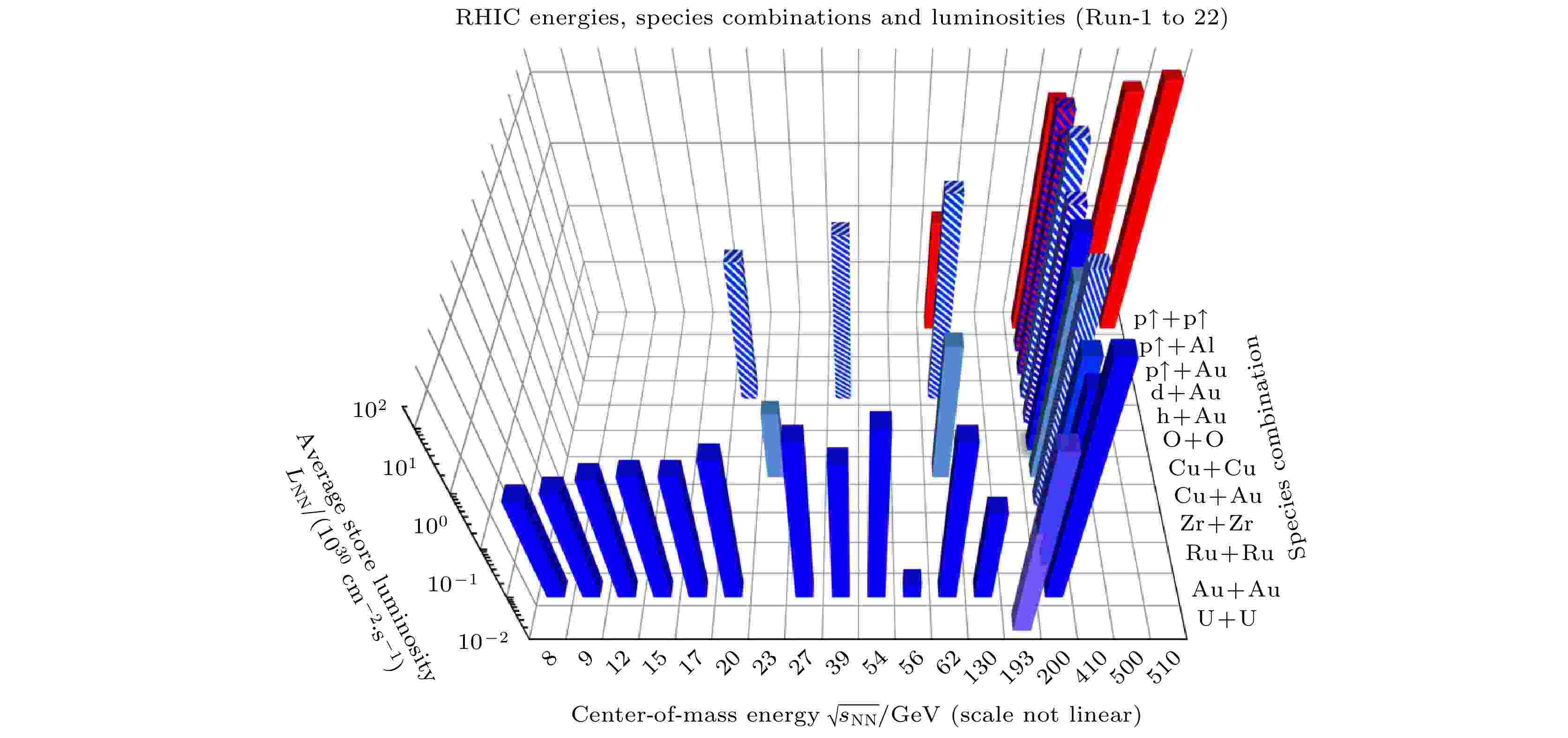
2023, 72 (11): 112401.
doi:10.7498/aps.72.20230496
Abstract +
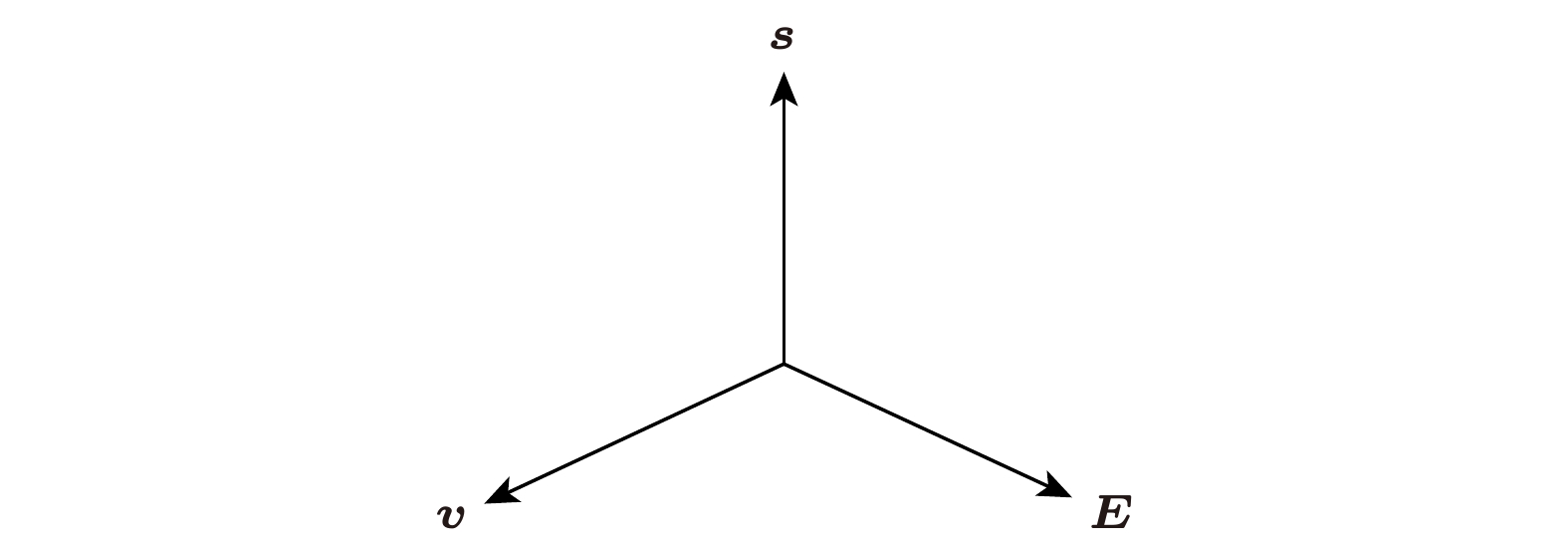
2023, 72 (11): 111201.
doi:10.7498/aps.72.20222458
Abstract +
Recently, the
$\Lambda$
polarization has been observed at relativistic heavy-ion collider (RHIC) and large hadron collider (LHC). This observation has inspired many studies on spin dynamics of quantum chromodynamics (QCD) many-body physics, thus opening a new avenue to studying the hot and dense nuclear matter.This paper reviews the recent progress of spin effects in relativistic heavy-ion collisions, with an emphasis on the quantum correlation between spin and motion in QCD matter, including newly discovered shear-induced polarization (SIP), a novel effect that fluid shear polarizes the spin. The linear response theory’s applications to studying those effects are also systematically reviewed. Finally, their observational signatures in experiments are discussed.
2023, 72 (11): 112501.
doi:10.7498/aps.72.20222470
Abstract +
Global polarization effect is an important physical phenomenon reflecting spin-orbit couplings in heavy ion collisions. Since STAR’s observation of the global polarization of
$\Lambda$
hyperons in Au+Au collisions in 2017, this effect has attracted a lot of interests in the field. In the hot and dense matter produced in heavy ion collisions, the spin-orbit couplings come from non-local collisions between particles, in which the orbital angular momentum involves the space and momentum information of the colliding particles, so it is necessary to describe the particle collisions with spin-orbit couplings in phase space. In addition, the spin-orbit coupling is a quantum effect, which requires quantum theory. In combination of two aspects, the quantum kinetic theory based on covariant Wigner functions has become a powerful tool to describe the global polarization effect. In this paper, we introduce the quantum kinetic theory for spin-1/2 Fermion system based on Wigner functions as well as the spin transport theory developed on this basis. The recent research progress of spin transport theory provides a solid theoretical foundation for simulating the space-time evolution of spin polarization effects in heavy ion collisions.

2023, 72 (11): 112502.
doi:10.7498/aps.72.20230245
Abstract +
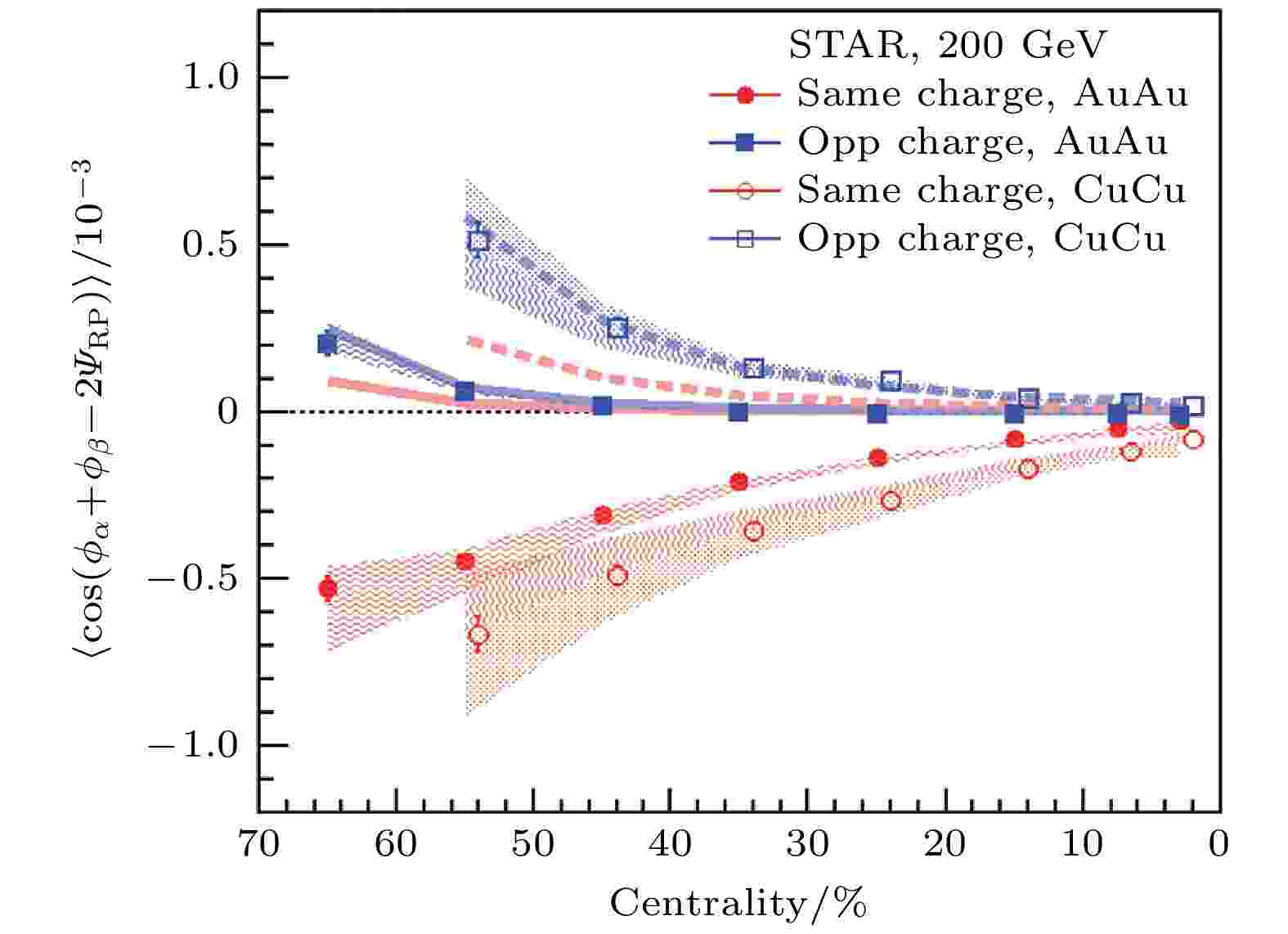
2023, 72 (11): 112504.
doi:10.7498/aps.72.20230109
Abstract +
In quantum chromodynamics, the interactions of quarks with the topological gluon field can lead to nonconservation of local parity (P) and conjugated parity (CP) , which provides a solution to the strong CP problem and a possibility to explain the asymmetry of matter-antimatter in the current universe. Under the action of a strong magnetic field, the nonconservation of P and CP can lead to the separation of particles according to their electric charges, which is called the chiral magnetic effect (CME). An observation of the CME-induced charge separation will confirm several fundamental properties of quantum chromodynamics (QCD), namely, approximate chiral symmetry restoration, topological charge fluctuation, and local parity violation. In relativistic heavy-ion collisions, there are other chiral anomalous effects similar to the CME, such as the chiral vortical effect (CVE) and the chiral magnetic wave (CMW). This review briefly summarizes the current progress of experimental research on the CME, CVE, and CMW in relativistic heavy-ion collisions.
2023, 72 (11): 112503.
doi:10.7498/aps.72.20222471
Abstract +
REVIEW
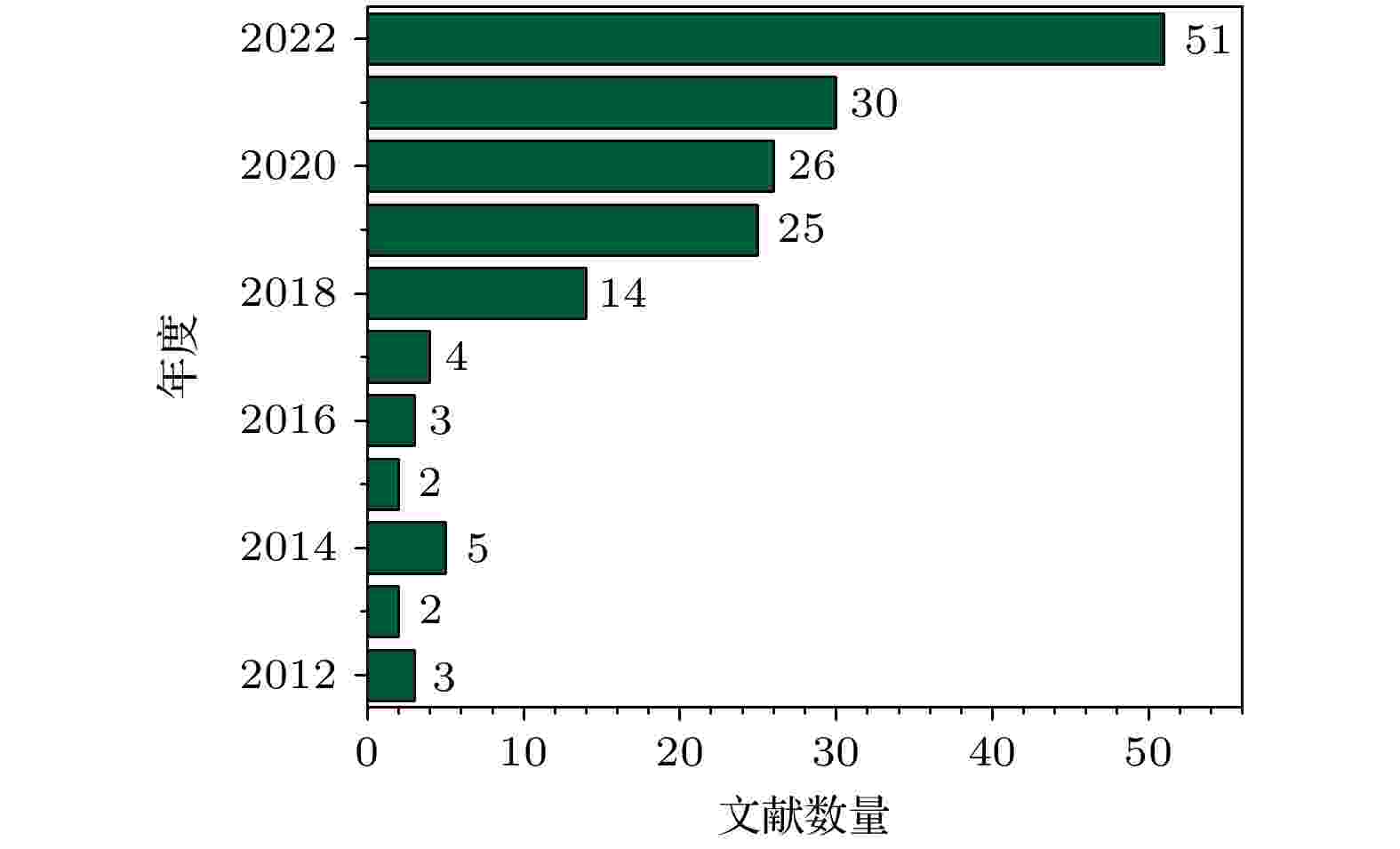
EDITOR'S SUGGESTION
2023, 72 (11): 114204.
doi:10.7498/aps.72.20230208
Abstract +
Micro/nano optical materials and devices are the key to many optical fields such as optical communication, optical sensing, biophotonics, laser, and quantum optics, etc. At present, the design of micro/nano optics mainly relies on the numerical methods such as Finite-difference time-domain (FDTD), Finite element method (FEM) and Finite difference method (FDM). These methods bottleneck the current micro/nano optical design because of their dependence on computational resources, low innovation efficiency, and difficulties in obtaining global optimal design. Artificial intelligence (AI) has brought a new paradigm of scientific research: AI for Science, which has been successfully applied to chemistry, materials science, quantum mechanics, and particle physics. In the area of micro/nano design AI has been applied to the design research of chiral materials, power dividers, microstructured optical fibers, photonic crystal fibers, chalcogenide solar cells, plasma waveguides, etc. According to the characteristics of the micro/nano optical design objects, the datasets can be constructed in the form of parameter vectors for complex micro/nano optical designs such as hollow core anti-resonant fibers with multi-layer nested tubes, and in the form of images for simple micro/nano optical designs such as 3dB couplers. The constructed datasets are trained with artificial neural network, deep neural network and convolutional neural net algorithms to fulfill the regression or classification tasks for performance prediction or inverse design of micro/nano optics. The constructed AI models are optimized by adjusting the performance evaluation metrics such as mean square error, mean absolute error, and binary cross entropy. In this paper, the application of AI in micro/nano optics design is reviewed, the application methods of AI in micro/nano optics are summarized, and the difficulties and future development trends of AI in micro/nano optics research are analyzed and prospected.

EDITOR'S SUGGESTION
2023, 72 (11): 118801.
doi:10.7498/aps.72.20230258
Abstract +
The development of all-solid-state lithium batteries with high energy density, long cycle life, low cost and high safety is one of the important directions for the developing next-generation lithium-ion batteries. Lithium-rich cathode materials have been widely used in liquid lithium batteries for their higher discharge specific capacity (> 250 mAh/g) and energy density (> 900 Wh/kg), high thermal stability and low raw material cost. With the rapid development of high-performance lithium-rich cathode materials and solid-state electrolytes in all-solid-state lithium batteries, the application of lithium-rich cathode materials in all-solid-state lithium batteries is expected to make a breakthrough toward the target of 500 Wh/kg energy density of lithium-ion batteries. In this review, first, we elaborate the failure mechanism of lithium-rich cathode materials in all-solid-state lithium batteries. The poor electronic conductivity, irreversible redox reaction of anionic oxygen and structute transformation during the electrochemical cycling of lithium-rich cathode materials result in the low initial coulomb efficiency, poor cycling stability and voltage decay. In addition, the high operating voltage of lithium-rich cathode materials (> 4.5 Vvs. Li/Li+) triggers off not only the conventional interfacial chemical reactions between anode and electrolyte, but also the release of oxygen, aggravating the interfacial electrochemical reactions, which reduces the stability of the cathode/electrolyte interface. Therefore, the intrinsic characteristics of lithium-rich cathode materials and the severe interfacial reaction of lithium-rich cathode/electrolyte greatly limit the application of lithium-rich cathode materials in all-solid-state lithium batteries. Then, we review the research progress of lithium-rich cathode materials in various solid-state electrolyte systems in recent years. The higher room temperature ionic conductivity and wider voltage window of inorganic solid-state electrolytes provide opportunities for the application of lithium-rich cathode materials in all-solid-state lithium batteries. At present, the application of lithium-rich cathode materials in all-solid-state lithium batteries is explored on the basis of sulfide, halide and oxide solid-state electrolyte systems, and important progress has been made in the studies of composite cathode preparation methods, interfacial reaction mechanisms and activation mechanisms. Finally, we summarize the current research hotspot of lithium-rich cathode all-solid-state lithium batteries and propose several strategies for their future studies, such as the regulation of cathode material components, the construction of lithium ion and electron transport pathways within the composite cathode, and the interfacial modification of cathode materials that have been shown to have significant effects in solving the failure problem.
GENERAL

2023, 72 (11): 110301.
doi:10.7498/aps.72.20221905
Abstract +
Quantum information and artificial intelligence are the two most cutting-edge research fields in recent years, which have made a lot of progress in changing the traditional science. It has become a hot topic of research to realize the cross fusion of the two fields. Scholars have made many explorations in this field. For example, they have simulated the steady state and the dynamics of open quantum many-body systems. However, little attention has been paid to the problem of accurate representation of neural networks. In this paper, we focus on neural network representations of quantum mixed states. We first propose neural network quantum mixed virtual states (NNQMVS) and neural network quantum mixed states (NNQMS) with general input observables by using two neural network architectures, respectively. Then we explore their properties and obtain the related conclusions of NNQMVS and NNQMS under tensor product operation and local unitary operation.To quantify the approximation degree of normalized NNQMVS and NNQMS for a given mixed state, we define the best approximation degree by using normalized NNQMVS and NNQMS, and obtain the necessary and sufficient conditions for the representability of a general mixed state by using normalized NNQMVS and NNQMS. Moreover, we explore the types of mixed states that can be represented by these two neural network architectures and show their accurate neural network representations.

2023, 72 (11): 110302.
doi:10.7498/aps.72.20230001
Abstract +
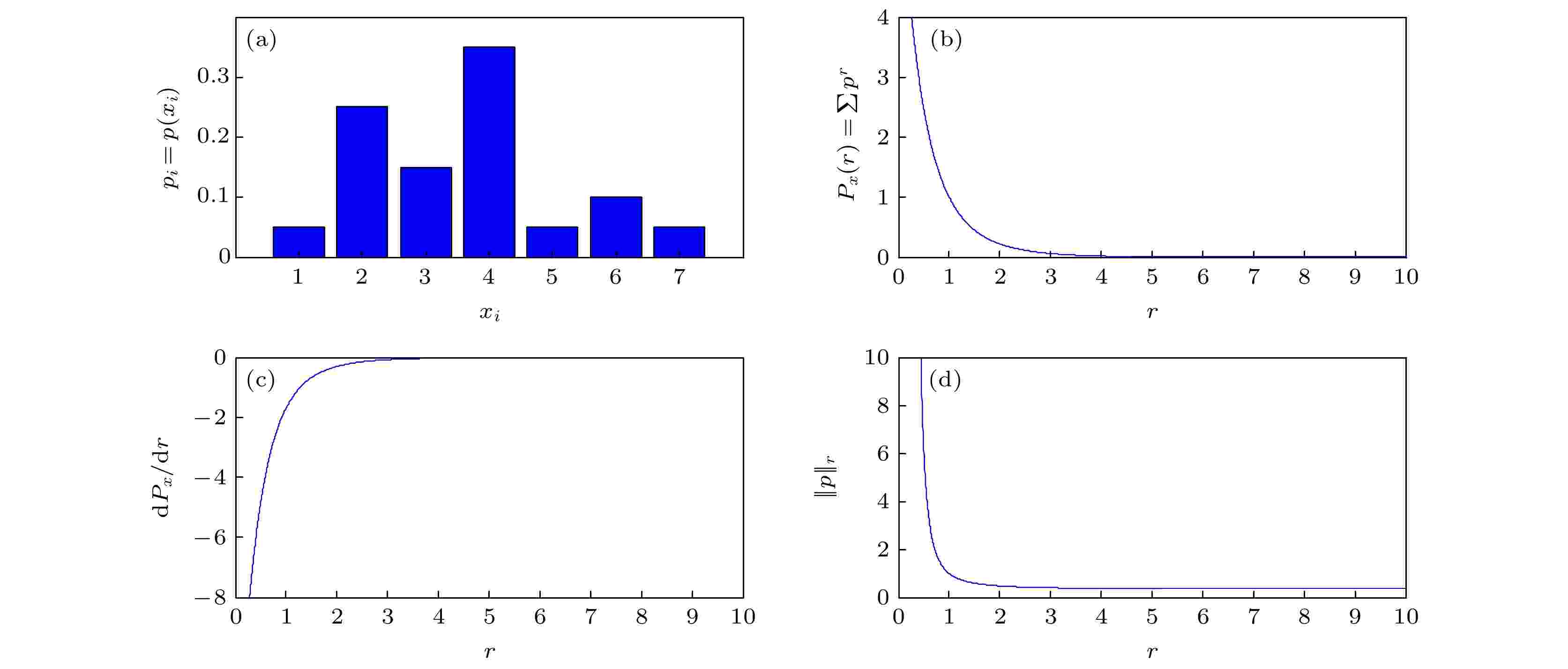
EDITOR'S SUGGESTION
2023, 72 (11): 110303.
doi:10.7498/aps.72.20222443
Abstract +
Uncertainty is a fundamental characteristic of quantum system. The degree of uncertainty of an observable has long been investigated by the standard deviation of the observable. In recent years, however, by analyzing some special examples, researchers have found that the Shannon entropy of the measurement outcomes of an observable is more suitable to quantify its uncertainty. Formally, Shannon entropy is a special limit of a more general Rényi entropy. In this paper, we discuss the problem of how to predict the measurement outcome of an observable by the existing measurement results of the observable, and how to quantitatively describe the uncertainty of the observable from the perspective of the repeatable probability of the measurement results of this observable in an unknown state. We will argue that if the same observable of different systems in the same state is repeatedly and independently measured many times, then the probability of obtaining an identical measurement result is a decaying function of the number of measurements of obtaining the same result, and the decay rate of the repeatable probability for obtaining the same measurement results and the repeatable number of measurements can represent the degree of uncertainty of the observable in this state. It means that the greater the uncertainty of an observable, the faster the repeatable probability decays with the number of repeatable measurements; conversely, the smaller the uncertainty, the slower the repeatable probability decays with the number of repeatable measurements. This observation enables us to give the Shannon entropy and the Rényi entropy of an observable uniformly by the functional relation between the repeatable probability and the number of repeatable measurements. We show that the Shannon entropy and the Rényi entropy can be formally regarded as the “decay index” of the repeatable probability with the number of repeatable measurements. In this way we also define a generalized Rényi entropy by the repeatable probability for consecutively observing identical results of an observable, and therefore we give a proof of the Maassen-Uffink type entropic uncertainty relation by using this generalized Rényi entropy. This method of defining entropy shows that entropic uncertainty relation is a quantitative limitation for the decay rate of the total probability for obtaining identical measurement results when we simultaneously measure two observables many times.
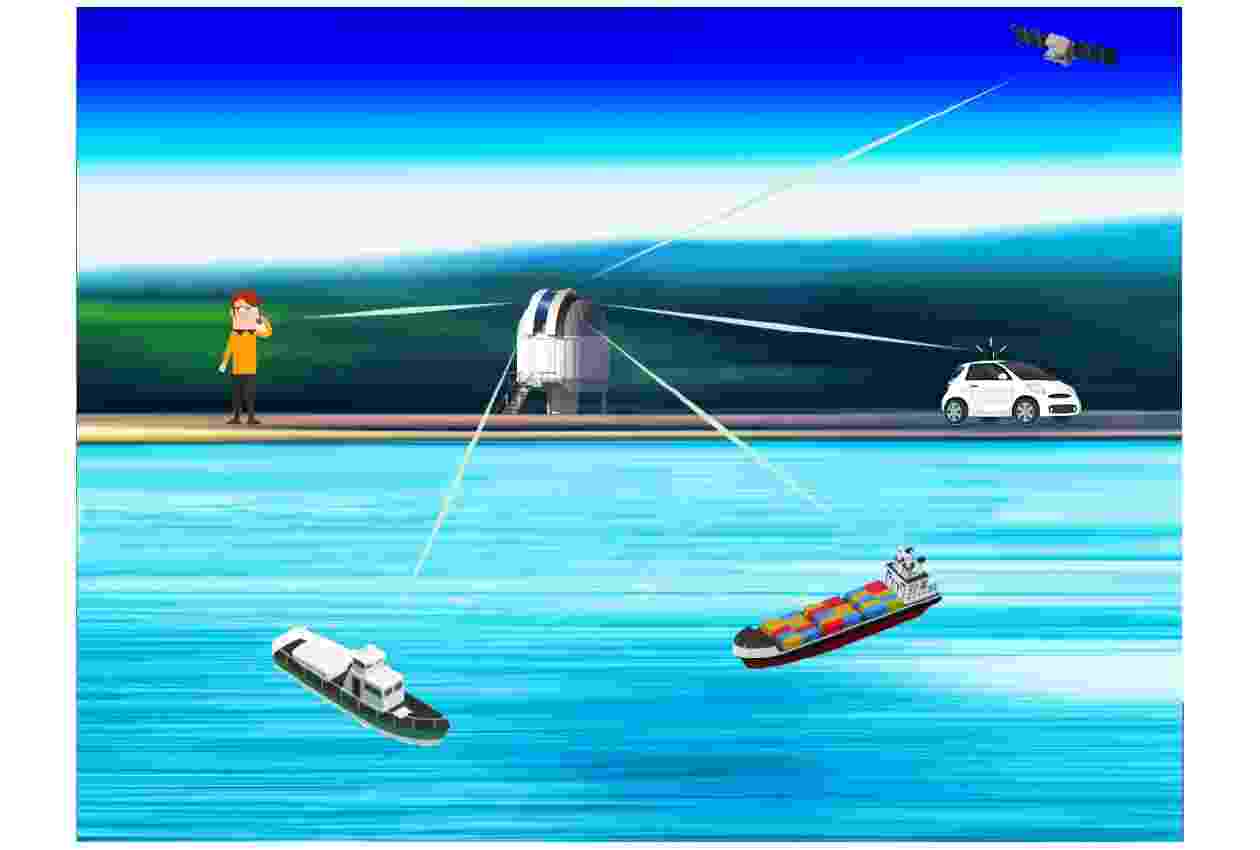
2023, 72 (11): 110304.
doi:10.7498/aps.72.20230160
Abstract +
The parameter configuration of quantum key distribution (QKD) has a great effect on the communication effect, and in the practical application of the QKD network in the future, it is necessary to quickly realize the parameter configuration optimization of the asymmetric channel measurement-device-independent QKD according to the communication state, so as to ensure the good communication effect of the mobile users, which is an inevitable requirement for real-time quantum communication. Aiming at the problem that the traditional QKD parameter optimization configuration scheme cannot guarantee real-time, in this paper we propose to apply the supervised machine learning algorithm to the QKD parameter optimization configuration, and predict the optimal parameters of TF-QKD and MDI-QKD under different conditions through the machine learning model. First, we delineate the range of system parameters and evenly spaced (linear or logarithmic) values through experimental experience, and then use the traditional local search algorithm (LSA) to obtain the optimal parameters and take them as the optimal parameters in this work. Finally, we train various machine learning models based on the above data and compare their performances. We compare the supervised regression learning models such as neural network, K-nearest neighbors, random forest, gradient tree boosting and classification and regression tree (CART), and the results show that the CART decision tree model has the best performance in the regression evaluation index, and the average value of the key rate (of the prediction parameters) and the optimal key rate ratio is about 0.995, which can meet the communication needs in the actual environment. At the same time, the CART decision tree model shows good environmental robustness in the residual analysis of asymmetric QKD protocol. In addition, compared with the traditional scheme, the new scheme based on CART decision tree greatly improves the real-time performance of computing, shortening the single prediction time of the optimal parameters of different environments to the microsecond level, which well meets the real-time communication needs of the communicator in the movable state. This work mainly focuses on the parameter optimization of discrete variable QKD (DV-QKD). In recent years, the continuous variable QKD (CV-QKD) has developed also rapidly. At the end of the paper, we briefly introduce academic attempts of applying machine learning to the parameter optimization of CV-QKD system, and discuss the applicability of the scheme in CV-QKD system.

COVER ARTICLE
2023, 72 (11): 110305.
doi:10.7498/aps.72.20230356
Abstract +
Quantum Fisher information plays a vital role in the field of quantum metrology and quantum information, because it not only quantifies the ultimate precision bound of parameter estimation but also provides criteria for entanglement detection. Nevertheless, experimentally extracting quantum Fisher information is intractable. Quantum state tomography is a typical approach to obtaining the complete information about a quantum system and extract quantum Fisher information. However it becomes infeasible for large-scale quantum systems owing to the exponentially growing complexity. In this paper, we present a general relationship between quantum Fisher information and the overlap of quantum states. Specifically, we show that for pure states, the quantum Fisher information can be exactly extracted from the overlap, whereas for mixed states, only the lower bound can be obtained. We also develop a protocol for measuring the overlap of quantum states, which only requires one additional auxiliary qubit and a single measurement for pure state. Our protocol is more efficient and scalable than previous approaches because it requires less time and fewer measurements. We use this protocol to characterize the multiparticle entanglement in a three-body interaction system undergoing adiabatic quantum phase transition, and experimentally demonstrate its feasibility for the first time in a nuclear magnetic resonance quantum system. We conduct our experiment on a 4-qubit nuclear magnetic resonance quantum simulator, three of which are used to simulate the quantum phase transition in a three-body interaction system, and the remaining one is used as the auxiliary qubit to detect the overlap of the quantum state. We use gradient ascent pulse engineering pulses to implement the process of evolution. By measuring the auxiliary qubit, the experimental results of quantum Fisher information are obtained and match well with the theoretical predictions, thus successfully characterizing the multiparticle entanglement in a practical quantum system. We further confirm our results by performing quantum state tomography on some quantum states in the adiabatic process. The experimentally reconstructed quantum states are close to the corresponding instantaneous ground states.
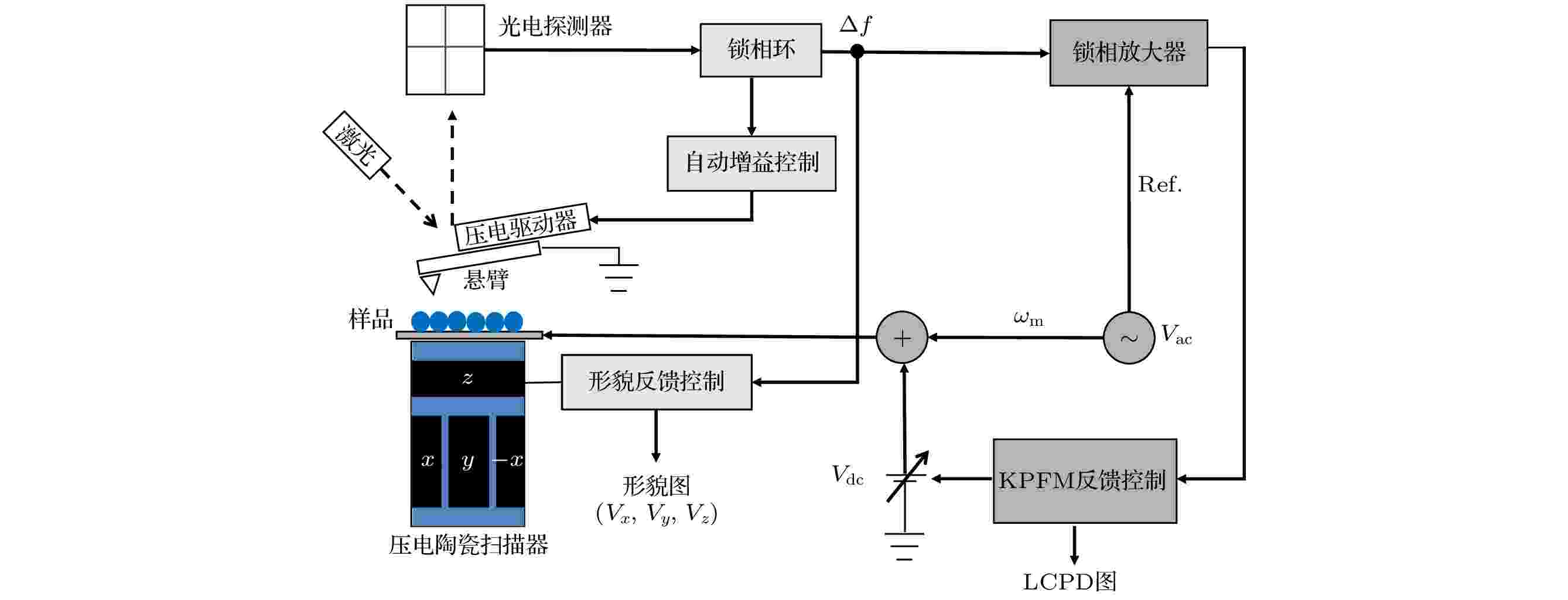
2023, 72 (11): 110701.
doi:10.7498/aps.72.20230051
Abstract +
The physicochemical properties of Au atoms adsorbed on the surface on an atomic scale play a very important role in preparing nanodevices and surface catalysis. In this paper, we use frequency modulated Kelvin probe force microscopy (FM-KPFM)to study the multi-bit adsorbed charge distribution of Au on the surface of Si(111)-(7×7) at room temperature. Firstly, the surface topography and local contact potential difference (LCPD) of Au at different adsorption sites in Si(111)-(7×7) are successfully obtained by using home-made ultra-high vacuum Kelvin probe force microscopy. Secondly, we analyze the atomic characteristics of specific atomic positions of Au/Si(111)-(7×7) by force spectroscopy and potential difference, and realize the atomic identification . The adsorption characteristics of Au/Si(111)-(7×7) surface charge transfer and Au are explained by combining differential charge density calculations. The results show that Au atom adsorption mainly is in the form of single atom and cluster . Specifically, the Au cluster is adsorbed at the three central positions of Si(111)-(7×7) in a hexagonal structure of six atoms. Individual Au atoms are adsorbed to the positions of central adatoms of Si(111)-(7×7). At the same time, through the measurement of potential difference, it is known that a single Au atom and Au cluster lose electrons, presenting a positive electrical characteristic. The results of surface differential charge density show that Au undergoes charge transfer during adsorption, losing part of the charge, which locally reduces the work function at the position of the adsorbed atom. In the range of distances where short-range forces, local contact potential energy differences and differential charge densities change, the theoretical results and experimental results are in reasonable agreement.
NUCLEAR PHYSICS
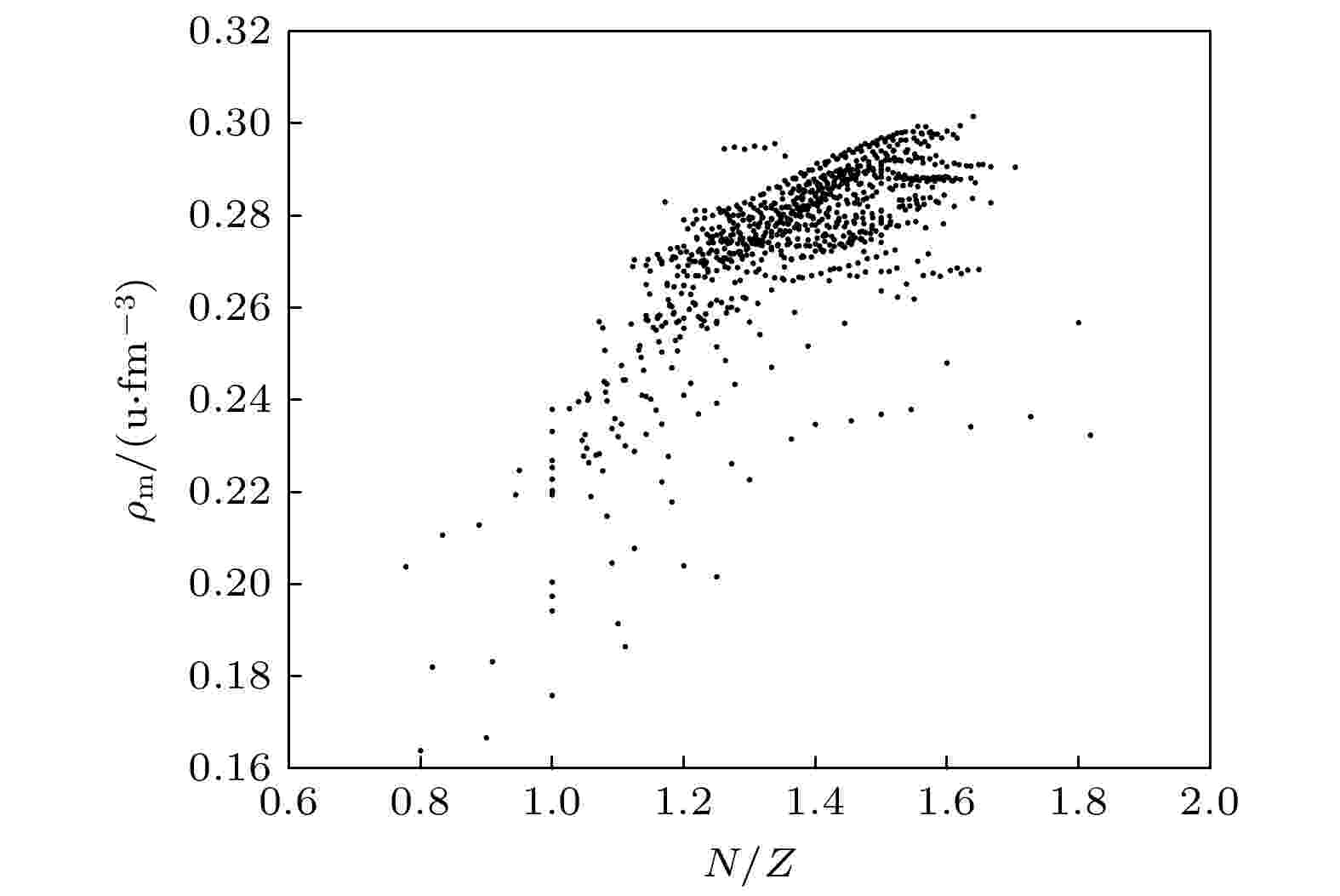
2023, 72 (11): 112101.
doi:10.7498/aps.72.20230126
Abstract +
In this paper we predict and evaluate the value of the nuclear charge radius by analyzing the relationship between nuclear mass and nuclear charge radius.We obtain 884 nuclei (Z,N≥ 8) with known mass and known charge radii by combining AME2020 database with CR2013 database, and calculate the mass densities
$ \rho_\text{m} $
of the 884 nuclei. We aim to obtain an empirical formula of one constant which is useful in describing and predicting nuclear charge radius. With the empirical formula and the AME2020 database, the root-mean-square deviation (RMSD) of the nuclear charge radius of
$ \sigma = 0.093 $
fm is successfully obtained.Considering the influence of neutron numbers on
$\rho_{\rm{m}}$
, we use the neutron factor
${1}/{N} $
to correct the empirical formula, and the RMSD is reduced toσ= 0.047 fm (the accuracy is increased by about 50%). The second correction is shell effect of neutrons. The results show that the RMSD of nuclear charge radius is reduced to 0.034 fm based on shell effect of neutrons. We use the empirical formula with corrections to predict the nuclear charge radius (1573 nuclear charge radius withZ,N≥ 8) which is difficult to measure experimentally. The difference between our predicted values based on AME2020 database and the experimental values measured in recent years is in the allowable range of deviation. The result shows that the new relation for nuclear charge radius is simple and reliable. In addition, the RMSD of the calculation value for 791 nuclei is reduced to σ = 0.032 fm after we have removed some nuclei with special shell effect and isotope chains. These results show that the new relation proposed in this paper can be comparable to
$ A^{1/3} $
and
$ Z^{1/3} $
formulas with corrections.Moreover, we study the 884 and 791 nuclear mass densities by using L-M neural network method to build description and prediction models. Comparing with CR2013, the RMSDs of nuclear charge radius areσ= 0.018 fm andσ= 0.014 fm, respectively. The RMSDs are reduced by about 50% compared with that from the empirical formula with corrections, and the predicted values are closer to the experimental values measured in recent years.
ATOMIC AND MOLECULAR PHYSICS
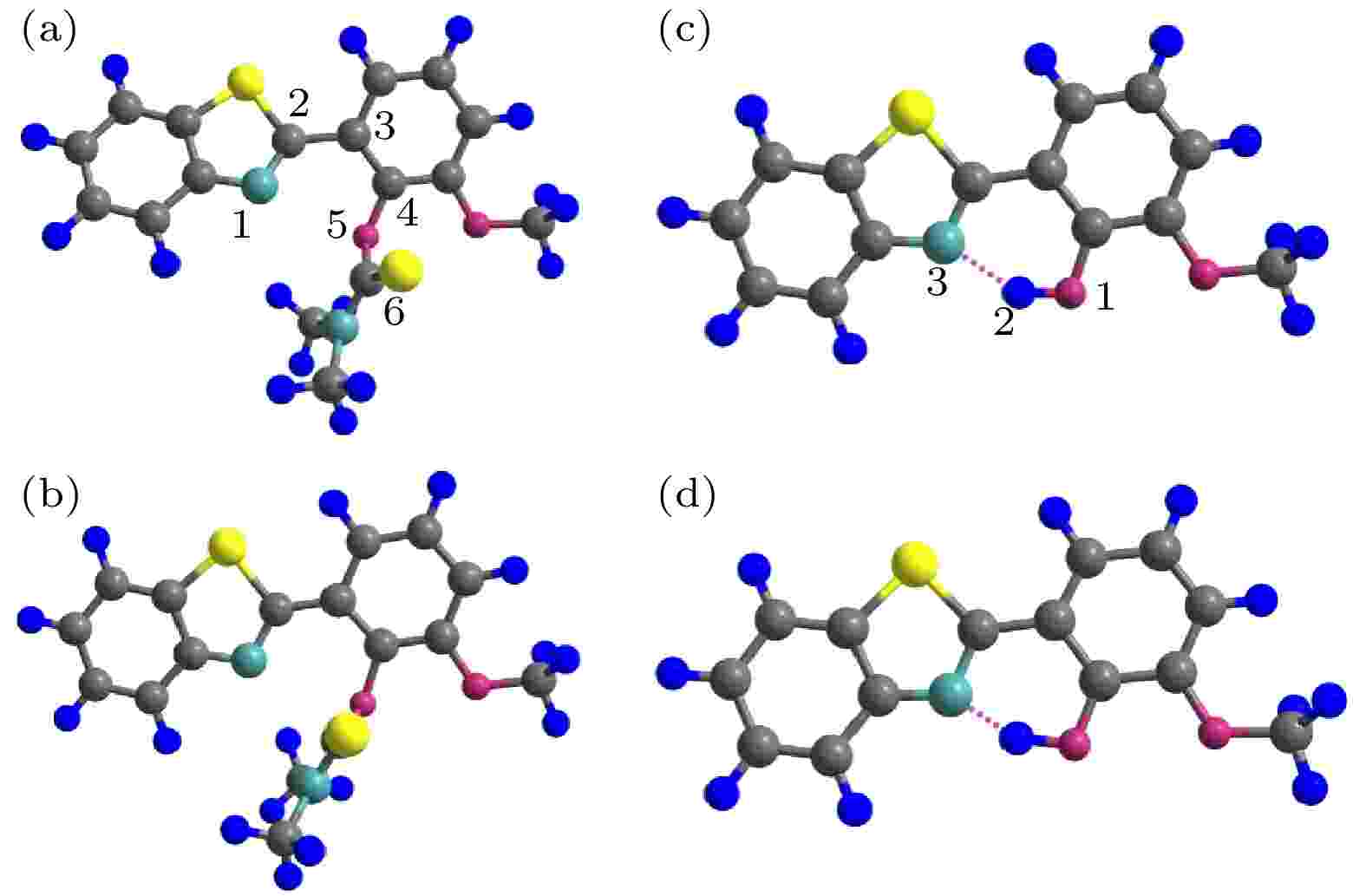
2023, 72 (11): 113101.
doi:10.7498/aps.72.20222313
Abstract +
The molecule with excited-state intramolecular proton transfer (ESIPT) has wide applications in fluorescent probe, biology imaging, light-emitting materials, etc. Biologically active oxygen hypochlorite (HClO) exists widely in the biological and chemical environment, which can pose a great threat to human health. Design of HClO-sensitive molecules in solvents is very important. Recently, Wu et al. [Wu L L, Yang Q Y, Liu L Y, et al.
2018
Chem. Commun.
548522
] designed an ESIPT-based HBT-OMe probe molecule, which can detect HClO due to its methoxy-hydroxy-benzothiazole. They found that the fluorescence intensity of the system gradually increases with HClO increasing. However, the microscopic mechanism of this highly efficient fluorescent probe is not well understood. Therefore, in this work, we theoretically investigate the ESIPT mechanism of the HBT-Ome and its product molecule by using density functional theory and time-dependent density functional theory. Based on polarizable continuum model (PCM) with the integral equation formalism variant (IEFPCM) and Becke’s three-parameter hybrid exchange function with the Lee-Yang-Parr gradient-corrected functional (B3LYP) as well as the TZVP basis, the optimized structures are obtained. The structures show that the HBT-Ome product molecules tend to undergo proton transfer in the excited state but HBT-OMe molecules cannot undergo the proton transfer process. The analysis of frontier molecular orbitals not only explains the reason why the fluorescence of the HBT-Ome product is enhanced, but also demonstrates that the HBT-Ome fluorescence intensity is diminished owing to twisted intramolecular charge transfer in the excited state. It is twisted intramolecular charge transfer that leads smaller charge density to be overlapped and the fluorescence intensity of HBT-OMe molecule to be further weakened. Infrared vibrational spectrum shows the enhancement of intramolecular hydrogen bond of O—H, which indicates the tendency of proton transfer. The molecular covalent interaction analysis shows that the intramolecular interactions of HBT-OMe remain largely unchanged clearly. The intramolecular O—H bonding interaction is weakened, and the N—H bonding interaction is increased for HBT-OMe product molecule. The enhancement of intramolecular hydrogen bond of N—H further illustrates the trend of proton transfer. The calculated potential energy curve provides direct evidence for the occurrence of ESIPT in the HBT-Ome product molecule. Our work is of great significance in designing and synthesizing the HClO fluorescent probes based on ESIPT molecules.

EDITOR'S SUGGESTION
2023, 72 (11): 113102.
doi:10.7498/aps.72.20230314
Abstract +
Regulating the interfacial thermal conductance is a key task in the thermal management of electronic devices, and implanting nanostructures at the interface is an effective way to improve the interfacial thermal conductance. In order to study the effect of the embedding of nanostructures on the thermal conductivity of the interface, the effect of embedding tin (Sn) nanodots at the interface on the interfacial thermal conductance of silicon-germanium (Si/Ge) composite material is investigated by using a non-equilibrium molecular dynamics simulation. It is found that the phonon transmission function of the hybrid interface with embedded nanodots is significantly larger than that of the perfect interface (there are no nanodots at interface). The enhanced transmission function plays a role in facilitating the thermal transport at the interface, which enhances the interfacial thermal conductance. The simulation results also indicate that the interfacial thermal conductance changes nonlinearly with the increase of the number of Sn nanodots, firstincreasing and then decreasing. This is attributed to the competition between two phonon transport mechanisms, which are elastic scattering of phonons and inelastic scattering of phonons. When four nanodots are inserted, the interfacial thermal conductance reaches a maximum value, which is 1.92 times that of a perfect interface. In order to reveal the reason why the interfacial thermal conductance varies nonlinearly with the number of nanodots, the transmission function and density of states of photons are calculated, and the result indicates that the increasing of interfacial thermal conductance is due to the enhancement of phonons inelastic scattering, which opens new channels for the interfacial phonons transport. As the number of nanodots increases to a certain value, the elastic scattering of phonons gradually dominates, and the interfacial thermal conductance starts to decrease. In addition, temperature is also a key factor affecting the interfacial thermal conductance. This study shows that as the temperature increases, more and more high-frequency phonons are excited, the phonons transmission function at the interface keeps increasing, and the enhanced inelastic scattering makes the interfacial thermal conductance keep increasing. This study provides theoretical guidance for improving the interfacial thermal conductance of electronic devices.
ELECTROMAGNETISM, OPTICS, ACOUSTICS, HEAT TRANSFER, CLASSICAL MECHANICS, AND FLUID DYNAMICS
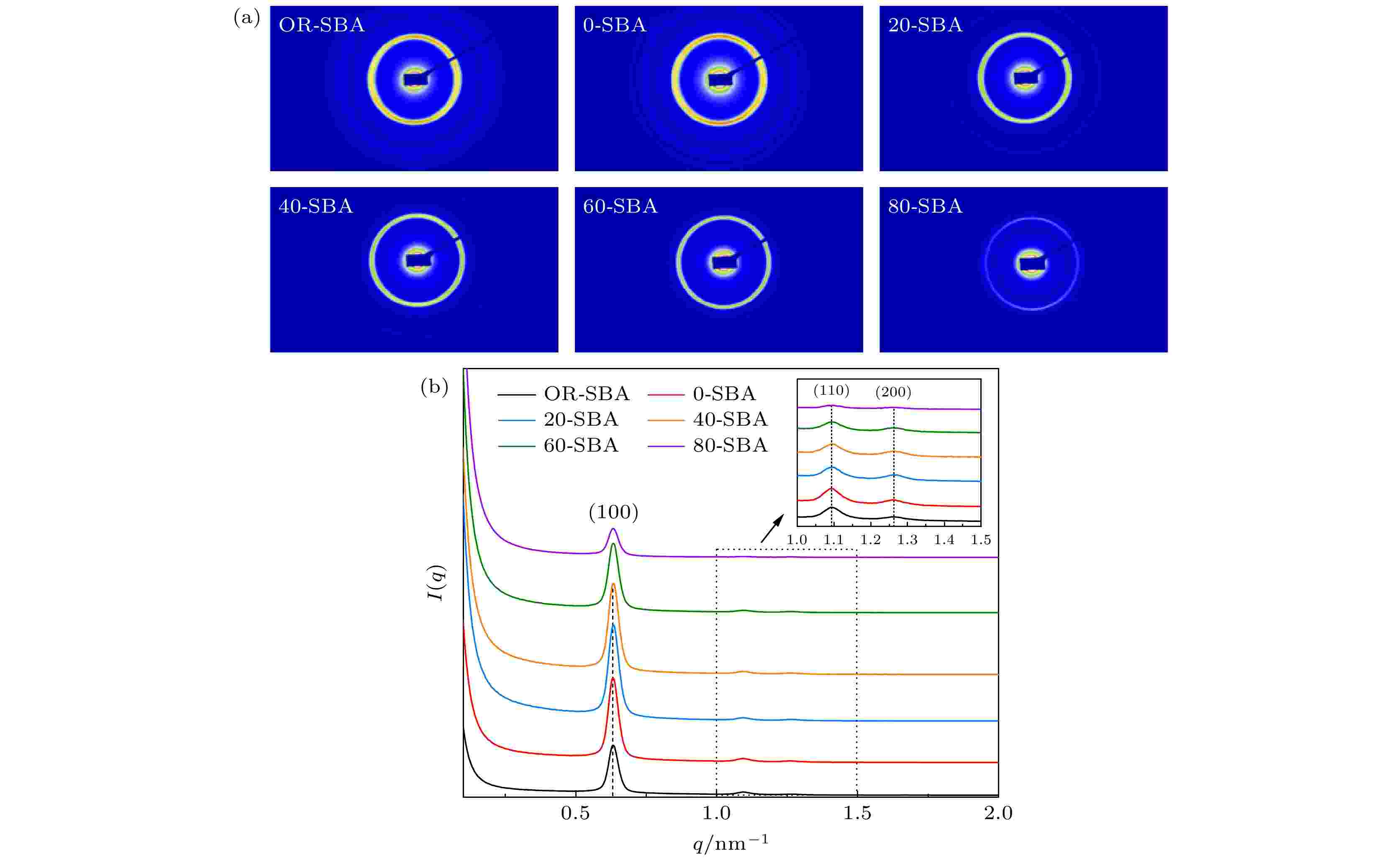
2023, 72 (11): 114101.
doi:10.7498/aps.72.20230265
Abstract +
Owing to its advantages of high specific surface area, large pore volume, adjustable pore size, good thermal stability and relatively low cost, SBA-15 has a wide range of application prospects in adsorption, separation, catalysis, nanomaterials and other fields. And the use of organic functional groups to modify SBA-15 has become one of the hot spots of research on materials, but the introduction of organic functional groups will inevitably affect the pore structure of material, affecting its performance. Therefore, how to more comprehensively characterize the pore structure of material has received much attention. In this work, small angle X-ray scattering (SAXS) technique is used to characterize the pore structure of PEI/SBA-15 mesoporous molecular sieve. The pore structure and periodicity information of PEI/SBA-15 are obtained by using correlation function and string length distribution theory, and compared with those obtained by positron annihilation lifetime spectroscopy (PALS) technique. The results show that the periodic structure of PEI/SBA-15 mesoporous molecular sieve does not change significantly with the increase of PEI mass percent, and the pore size of PEI/SBA-15 mesoporous molecular sieve only decreases from 8.3 nm to 7.6 nm by the chord length distribution function. Two long-life components, τ3andτ4, are obtained by PALS, andτ3reflects the random pores structure in SBA-15 matrix, whileτ4denotes the size of SBA-15 hexagonal pores. Compared with the results of SAXS, the mesoporous pore size obtained by PALS technique shows the same trend. By combining SAXS technique and PALS technique, the evolution of material microstructure can be revealed in more depth, thus providing a unique method for studying the structural characterization of functional nanocomposites in the future.
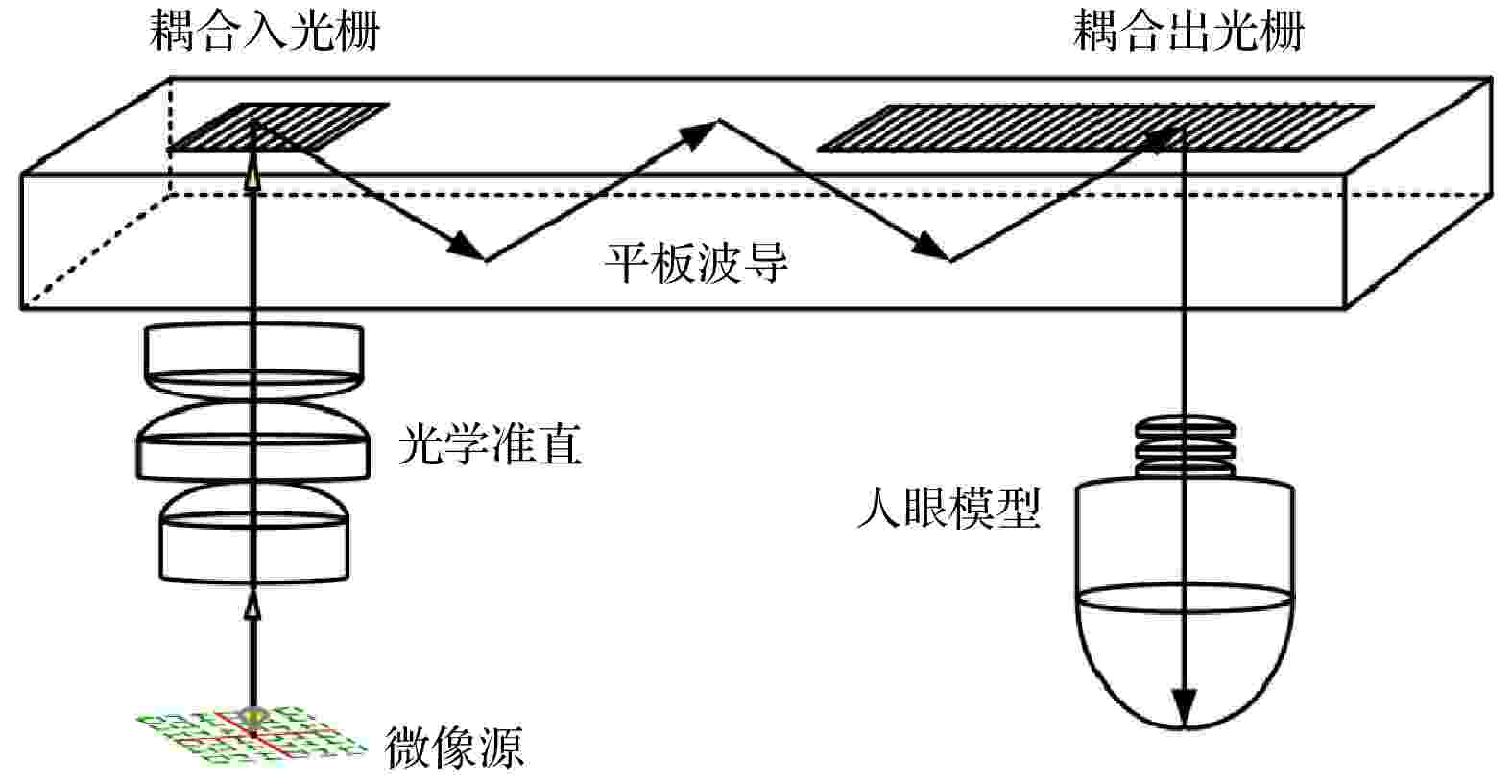
2023, 72 (11): 114201.
doi:10.7498/aps.72.20222388
Abstract +
Holographic optical element (HOE) lens is an imaging element fabricated through recording wavefront by interference. Because of its advantages of small form factor and wavelength, angle selectivity and arbitrary wavefront formation, it has a good application prospect in augmented reality display. To make the system more compact, the HOE lens is adopted as an off-axis optical element. At the same time, according to diffraction principle, its wavelength response is more sensitive than those of traditional refractive and reflective optical elements. Thus the fabrication and design of a full-color HOE lens is a challenge to optimizing the free-space head-up display system. To systematically analyze the HOE imaging system, the conjugate relation between the object and image is derived by scalar diffraction theory. Then the Gaussian conjugate imaging equation is obtained and the off-axis aberration of distortion and astigmatism in the HOE imaging system are analyzed. In addition, A head-up display with field of view (FOV) of 18° and eyebox of 10 mm is simulated and its imaging process is visualized through the geometric optics method ofk-vector diagram and ray-tracing. A full-color HOE lens with high diffraction efficiency is fabricated by interference. Its average peak diffraction efficiency is 56.7%, reaching a high level in the world. A prototype of augmented reality system is established by integrating laser pico-projectior with HOE lens. The experimental results of distortion effect and astigmatism effect of the system are obtained, which are consistent with the simulation results. The modulation transfer function (MTF) parameter of the system is measured, and its definition basically meets the requirements of the human eyes for resolution. The aberration of the system is analyzed and the optimization method is proposed. To optimize the monochromatic image quality, an extra cylindrical lens is added to ensure the same optical power of meridian and sagittal plane to eliminate the astigmatism. Besides, a freeform wavefront is designed by the geometric construction method and forms a freeform HOE to deal with the distortion problem. The local recording freeform wavefront can be calculated by the imaging equation. When full-color HOE is applied to the display system, the images of three channels may separate in the space because of their different reconstruction wavelengths and angles. We propose a pre-compensation method of recording process to solve this problem. If these above-mentioned problems can be solved, due to its good image uniformity, sufficient field angle and eyebox area, the head-up display based on HOE lens with extra optical power will have a better application in augmented reality technology.
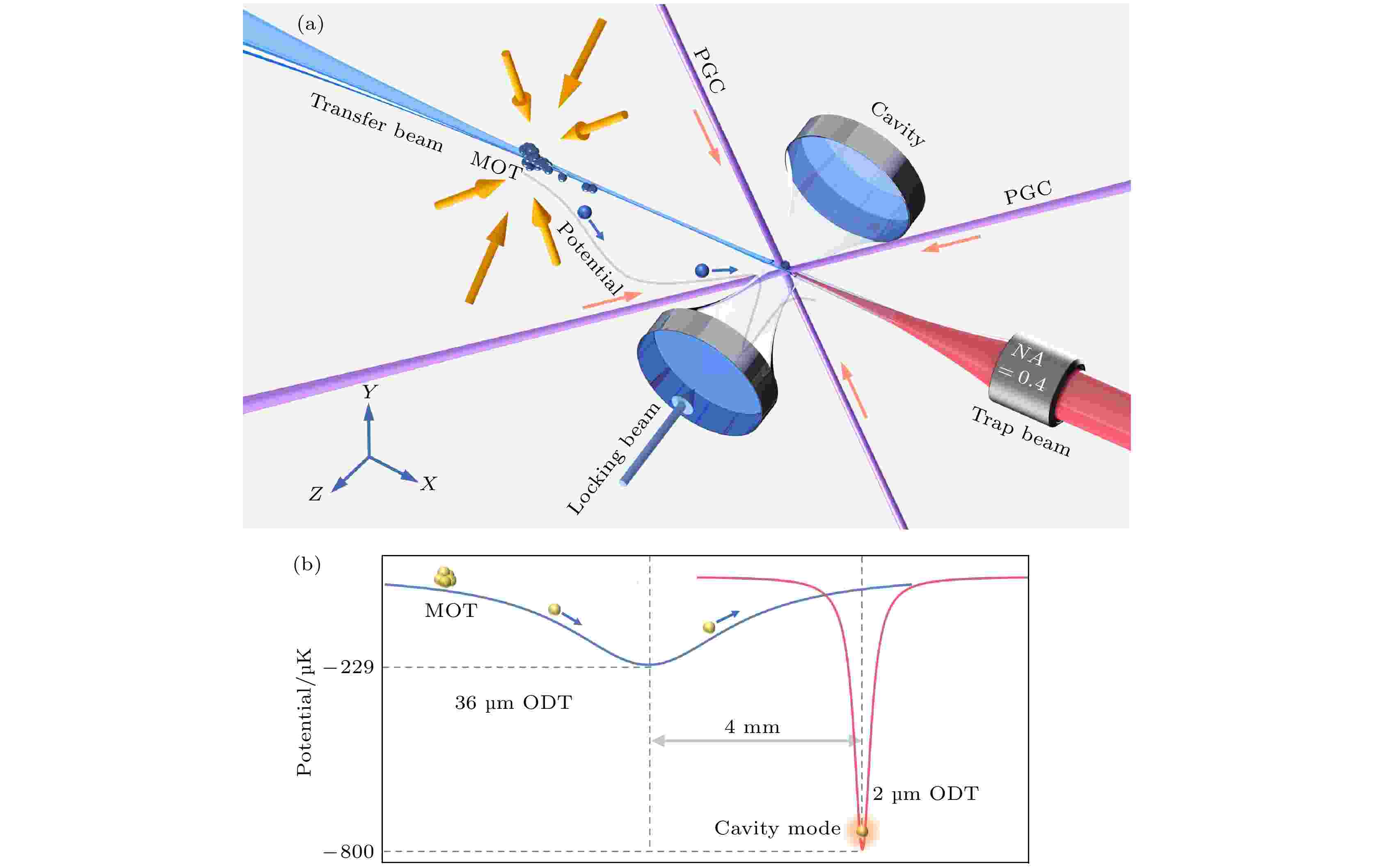
2023, 72 (11): 114202.
doi:10.7498/aps.72.20222220
Abstract +
Cavity quantum electrodynamic system with strongly coupled single atoms provides a good platform for studying quantum information processing, quantum simulation, quantum network, and distributed quantum computing. Cooling and trapping single atoms is a crucial technique in the quantum technology. At present, in a high-finesse cavity with finite space, cooling and trapping single atoms is a big challenge, even though it is a mature technique for free space. Great efforts have been made to cool and trap single atoms inside a cavity, and for a trapped atom its lifetime has reached as long as tens of seconds. Developing a more flexible method of cooling and trapping single atoms in a cavity is still essential for a strongly coupled cavity quantum electrodynamic system. In this work, we demonstrate experimentally that a single cesium atom in a cavity can be trapped by utilizing a single optical tweezer settled in cavity mode, and its lifetime is (2.60 ± 0.18) s. The experiment is carried out in a Fabry-Perot cavity, which is assembled by two concave mirrors each with a curvature radius of 100 mm, and cavity length of 335 μm. The concave surfaces are highly reflective, and the cavity has a finesse of 6.1 × 104. The 1080 nm optical tweezer with a waist of 2 μm is formed by an achromatic lens group with a numerical aperture of 0.4. At first, the precooled atomic assemble released from the magneto-optical trap (MOT) is transferred into cavity mode by an optical dipole trap with a waist of 36 μm. Then, one of the successfully transferred atoms is captured by the optical tweezer with the aid of cavity cooling mechanism. A blue detuned cavity locking laser is used as a standing-wave optical trap along the cavity axis. The signal of successfully trapped one atom is obtained by recording transmission of the cavity that will decrease owing to the strong coupling induced vacuum Rabi splitting. Finally, we demonstrate the precise manipulation of the atom-cavity coupling strength, which is achieved by scanning the position of the trapped atom step by step by using a high-precision translation stage. The system realized in this work can be used to study the dynamics of single atom-photon interactions with adjustable coupling strength. In addition, the mechanism adopted in this work is compatible with constructing tweezer arrays inside cavity mode, and thus possesses more flexibility and great potentials in cavity-based quantum entanglement and quantum simulation.
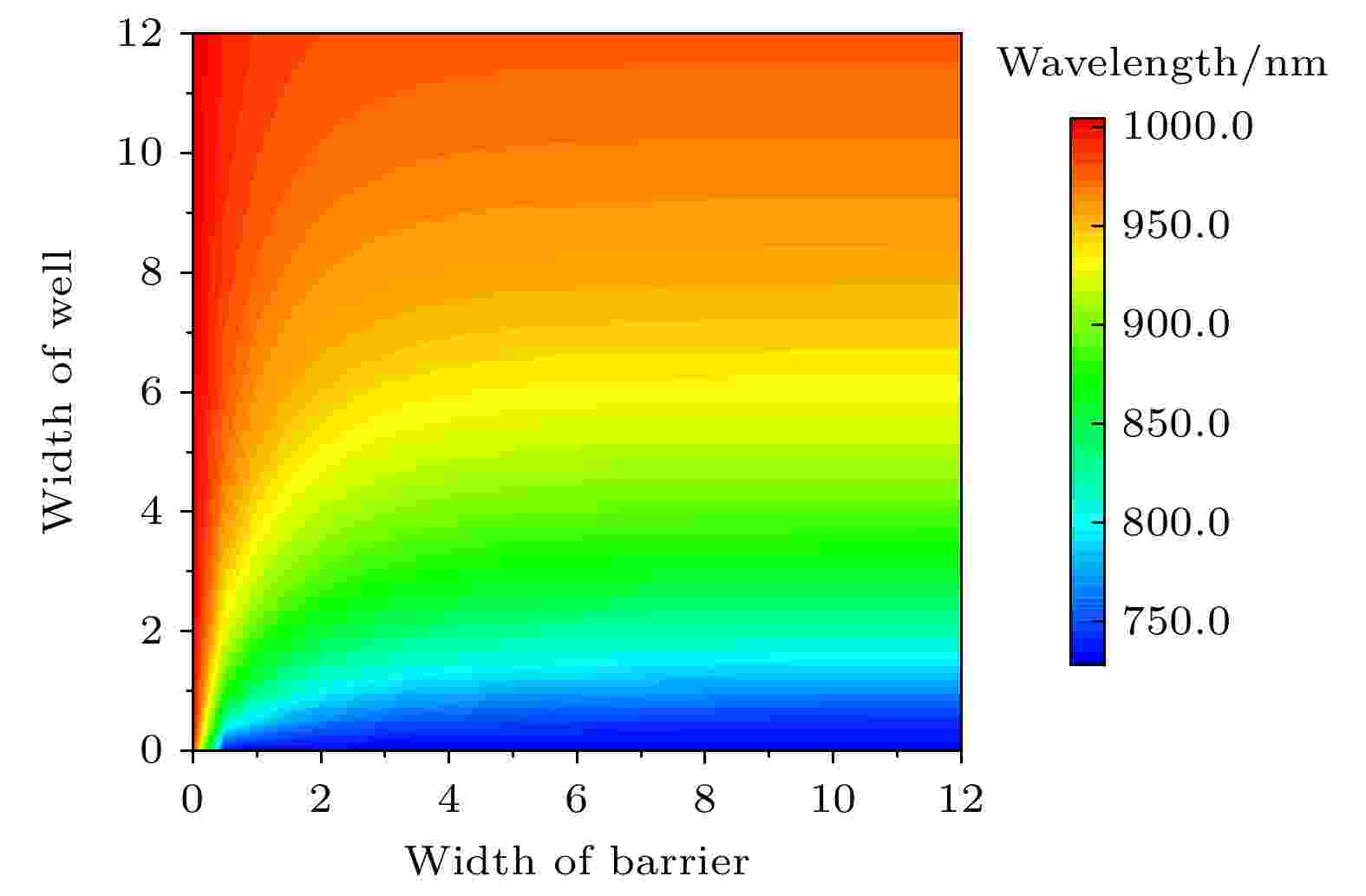
2023, 72 (11): 114203.
doi:10.7498/aps.72.20230297
Abstract +
As a key part of vertical cavity surface emitting laser (VCSEL), active region will seriously affect the threshold and efficiency of the device. To obtain the appropriate laser wavelength and material gain, the design of In0.18Ga0.82As strain compensated quantum well is optimized. The relationship between the lasing wavelength of multiple quantum wells (MQWs) and the thickness is calculated. Considering the influence between the active region temperature and the lasing wavelength, the thickness of the quantum well is chosen as 6 nm, and the quantum barrier thickness is chosen as 8 nm, corresponding to the lasing wavelength of 929 nm. The material gain characteristics of the MQWs at different temperatures are simulated by Rsoft. The material gain exceeds 3300/cm at 300 K, and the temperature drift coefficient of the peak wavelength is 0.3 nm/K. In this work, Al0.09Ga0.91As and Al0.89Ga0.11As are chosen as the high- and the low-refractive index material of distributed Bragg reflector (DBR), and 20 nm graded layer is inserted between two types of materials. The influence of the graded layer thickness of DBR on the valence band barrier and reflection spectrum are calculated and analyzed. The increase of graded layer thickness can lead the band barrier peak and the reflection spectrum bandwidth to decrease. The reflection spectrum and phase spectrum of P-DBR and N-DBR are calculated by the transmission matrix mode (TMM): the reflectance of DBR is over 99% and the phase shift is zero at 940 nm. The optical field distribution of the whole VCSEL structure is simulated, in which the standing wave peak overlaps with the active region, and the maximum gain can be obtained. Using the finite element method (FEM), the effect of oxidation confined layer on the injection current is simulated. The current in the active region is effectively limited to the position corresponding to the oxidation confined hole, and its current density is stronger and more uniform. The optical field distributions in different modes of photonic crystal-vertical cavity surface emitting laser (PC-VCSEL) are simulated, and different modes have different resonant wavelengths. The values of quality factor Q in different modes of VCSEL and PC-VCSEL are calculated, Q of the fundamental mode is higher than that of higher transverse mode. It is demonstrated that the photonic crystal air hole structure can realize the output of basic transverse mode by increasing the loss of high order transverse mode. The VCSEL and PC-VCSEL with oxidation hole size of 22 μm are successfully fabricated, in which the photonic crystal period is 5 μm, the air pore diameter is 2.5 μm, and the etching depth is 2 μm. Under continuous current test, the maximum slope efficiency of VCSEL is 0.66 mW/mA, the output power is 9.3 mW at 22 mA, and the lasing wavelength is 948.64 nm at 20 mA injection current. Multiple wavelengths and large spectrum width are observed in the spectrum of VSCEL, which is an obvious multi-transverse mode. The maximum fundamental transverse mode output of PC-VCSEL reaches 2.55 mW, the side mode suppression ratio (SMSR) is more than 25 dB, and the spectrum width is less than 0.2 nm, indicating that the photonic crystal air hole has a strong control effect on the transverse mode, and the laser wavelength is 946.4 nm at 17 mA.

2023, 72 (11): 114701.
doi:10.7498/aps.72.20222371
Abstract +
The surface tension plays a significant role in the hygroscopicity of aerosol particles on a nanoscale. However, it cannot be obtained by using the existing measurement techniques. In this study, we simulate the hygroscopic growth of one single succinic acid (SA) particle by using the molecular dynamic (MD) method. Based on the MD simulation results, the surface tension of the stable SA-water droplet is calculated by using a numerical model. Furthermore, the influencing mechanisms of temperature, diameter and concentration of SA on the surface tension of the nanoscale droplet are investigated. The results show that with the temperature increasing from 260 K to 320 K, the surface tension of the droplet decreases, which is mainly caused by the weakening of the intermolecular forces inside the droplet. Besides, the sensitivity of the surface tension to the temperature increases with the increasing SA concentration, which can be explained by the effect of the temperature and the SA concentration on the radial distribution of SA molecules. With the increase of the particle diameter, the surface tension of droplet first increases and then tends to be constant. The normal components of the Irving-Kirkwood pressure tensors are calculated to explain the effect of diameter and SA on the surface tension. In addition, when the SA concentration is increased, the particle diameter range which has an obvious effect on the surface tension is reduced. Moreover, the surface tension of the nanodroplet is negatively correlated with the SA concentration, and the correlation fits into the logarithmic function form, especially for droplet with a diameter smaller than 6.12 nm. The Szyszkowski equation is employed to fit the relationship between SA concentration and the surface tension of droplet. These findings can provide parameter support for improving the theoretical model of particle hygroscopicity and related kinetic processes. This study emphasizes further research on the surface tension of nano-droplets with more complex components.
PHYSICS OF GASES, PLASMAS, AND ELECTRIC DISCHARGES
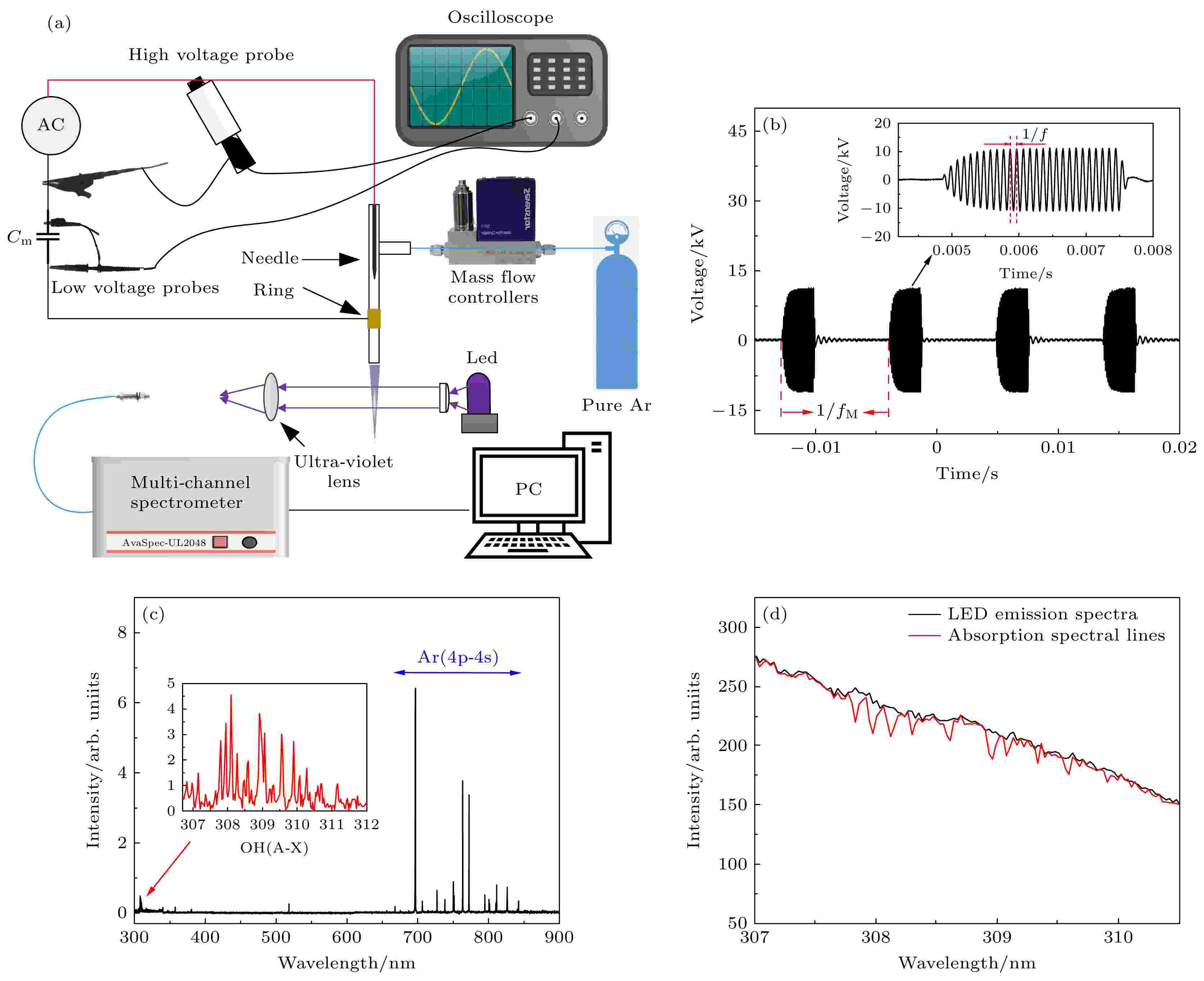
2023, 72 (11): 115201.
doi:10.7498/aps.72.20230307
Abstract +
In the application of atmospheric pressure plasma jet, because the frequency of AC power supply is limited in the kHz range, the research on the influence of power supply electrical parameters on discharge is basically aimed at the variation of plasma jet characteristics with a single driving electrical parameter ( such as voltage and frequency). However, the discharge power usually changes with a single electrical parameter changing, which can undoubtedly affect the discharge performances including the plasma physical parameters and generated reactive species, resulting in the failure to reflect the influence of the single driving parameter on the discharge. In this study, an atmospheric pressure argon plasma jet is driven by a home-made AC power supply with adjustable pulse modulated duty cycle. And combining the diagnosis of the optical emission spectrum and the optical absorption spectrum, the influences of the voltage, frequency and pulse modulated duty cycle parameters on the gas temperatureTg, electron excitation temperatureTexc, electron densityne, and OH radical particle number density of the plasma jet are studied under a constant discharge power of 2 W. The results show that at the constant power, the electron density nedoes not change with the variation of electrical parameters as the linkage change of electrical parameters will offset the influence of a single parameter on the electron density, while the gas temperatureTg, electron excitation temperatureTexc, and OH radical particle density are most affected by the pulse modulated duty cycle, followed by driving voltage, and the frequency effect is the smallest. Under the constant power, as the frequency decreases, the voltage will increase, and also the gas temperatureTg, electron excitation temperatureTexc, and OH radical particle number density will increase. On the contrary, although the voltage also increases as the pulse modulated duty cycle decreases, the gas temperatureTg, electron excitation temperatureTexc, and OH radical particle number density are all reduced. In addition, the results indicate that reducing the duty cycle of AC power can make the atmospheric pressure plasma jet produce more OH radicals at lower gas temperature. This study provides a new insight into the influence of electrical parameters on the characteristics of atmospheric pressure plasma jets under constant power, and also presents a guidance for choosing power parameters of plasma jets with low gas temperature and high density of reactive species, which is conducive to the development of atmospheric pressure plasma jets in biomedicine and other fields.
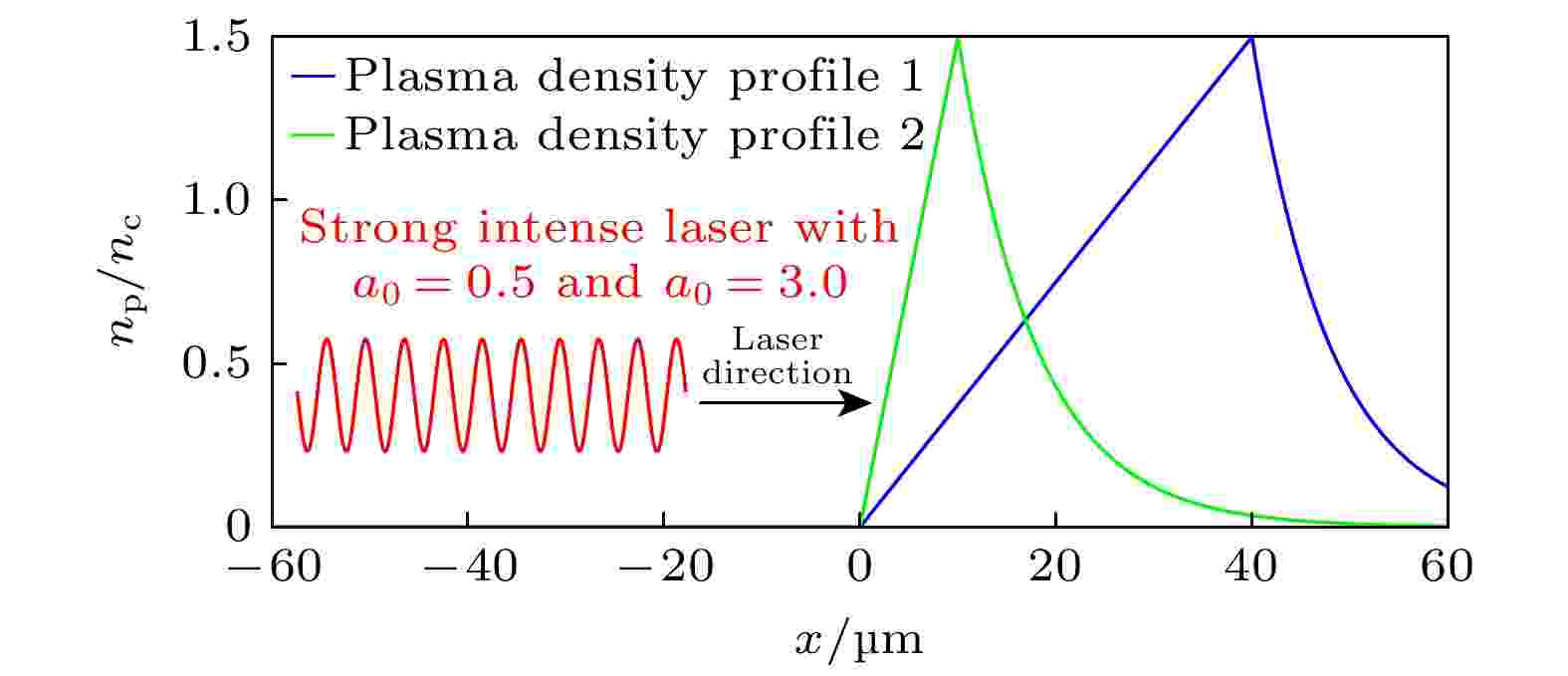
EDITOR'S SUGGESTION
2023, 72 (11): 115202.
doi:10.7498/aps.72.20230271
Abstract +
Weak and strong collisionless electrostatic shock wave (CESW) generated in the interaction between strong intense laser and near-critical-density plasma are studied by the one-dimensional particle-in-cell simulation in this work. And the effects of the ranges of plasma density profiles, non-relativistic and relativistic laser intensities on the generation of CESWs are also investigated. The non-relativistic weakly driven laser generates the weak CESW in the interaction between the laser and near-critical-density plasma. The electron spectra show double-temperature distribution because the non-relativistic driven laser cannot heat the electrons sufficiently. The low-temperature electrons have an important influence on the generation of weak CESW, and they can also cause the protons to be accelerated and reflected from the CESWs. The spectra of the weak CESW protons show a continuously distributed profile. When the range of plasma density up-ramp is large, the process can be observed that the post-soliton structure evolves into the ion acoustic wave and further into the weak collisionless electrostatic shock wave. When the driven laser intensity is relativistic, the electrons are heated sufficiently to a single relativistic temperature. The effect of the range of plasma density profile on the generation of CESW is further analyzed and it is found that 1) when the range of plasma density up-ramp is large, the potential barrier of ion acoustic wave is shielded by the hot electrons; 2) when the range of plasma density up-ramp is small, the effective distance (i.e. the Debye length) of accelerating field is larger and the endurance time is longer than when the range of plasma density up-ramp is large. This makes the ion acoustic wave structure more stable in its forward propagation process. When the difference in velocity between the ion acoustic wave accelerating protons and the target normal sheath accelerating protons satisfies the proton reflection condition of CESW, the ion acoustic wave further evolves into the strong CESW, the monoenergetic protons generated at the same time.
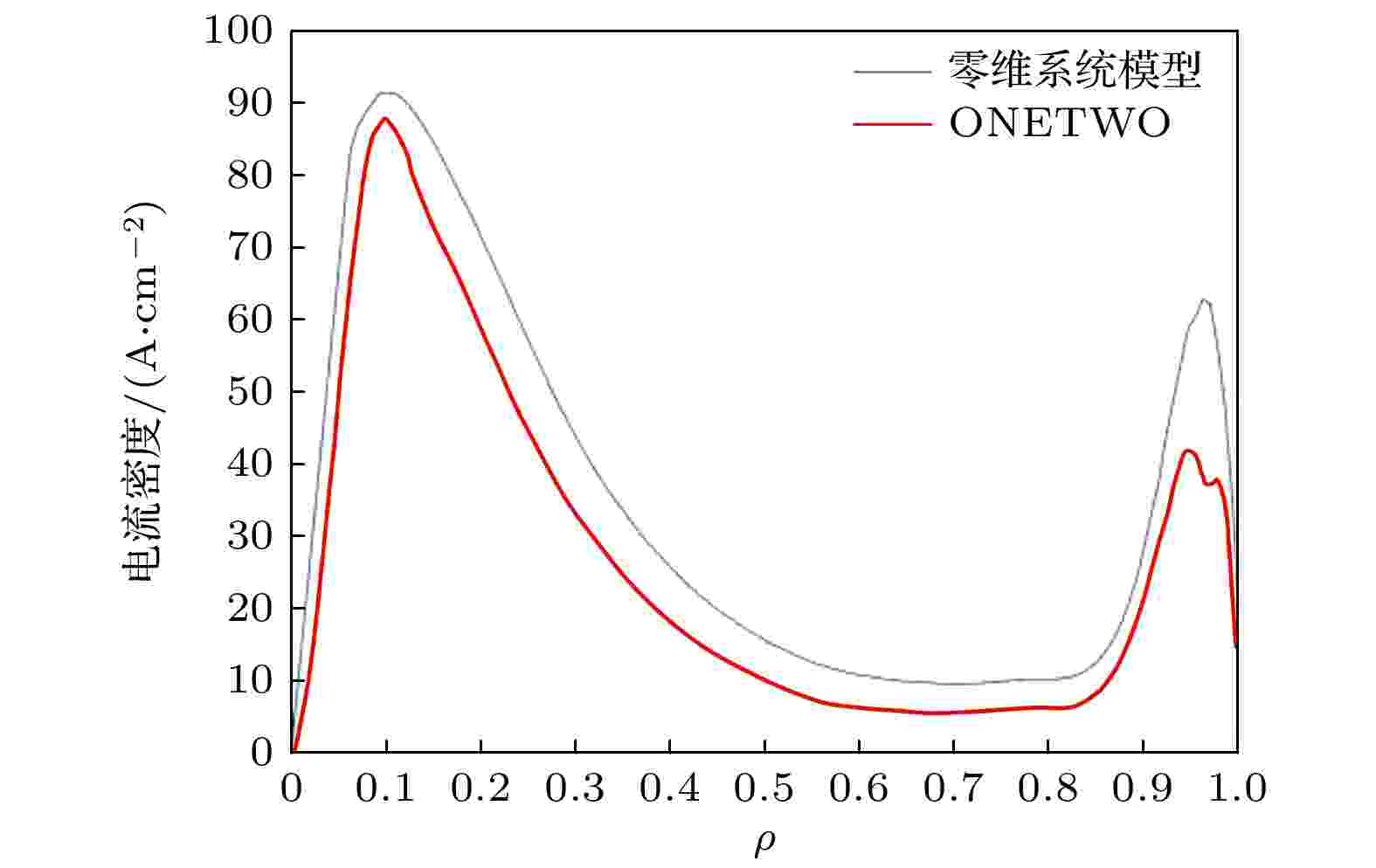
2023, 72 (11): 115203.
doi:10.7498/aps.72.20230364
Abstract +
The zero-dimensional system model has been widely used for predicting and analyzing plasma performance in fusion reactors and designing next-generation tokamaks. These models can quickly scan and calculate various parameter, and can be used for the design of device reference operation point and preparation for more accurate one-dimensional numerical simulations. They can also be used to predict device operational parameters and heating/ current drive conditions, providing a quick reference for experimental design. However, relying on physical approximations and empirical formulas can lead to significant systematic errors. In this work we introduce a plasma equilibrium program to obtain the main plasma profile parameters and their calculations based on magnetic surface information. The bootstrap current calculation is improved by introducing the relationship between the bootstrap current coefficient of the Sauter model and the collision rate change. The improved model is validated by using experimental results from EAST, and the results of the zero-dimensional system model calculations are found to be consistent with the results of kinetic equilibrium analysis. Based on the improved model and existing experimental results, the required heating/current drive power and achievable normalized beta for steady-state, long-pulse operation of the 500 kA plasma current on EAST are analyzed and predicted. The calculation results show that EAST can achieve steady-state operation at the 500 kA plasma current with bootstrap current fraction over 50% in the parameter range of 7.0–9.5 MW heating/driving power,
$ {H}_{98} $
is 1.25–1.35, and
$ {f}_{{\rm{n}}{\rm{G}}} $
~0.9. Additionally, to maintain the total non-inductive current, the total heating/current drive power needs to be highly sensitive to plasma confinement and density, which is the most effective way to increase the bootstrap current fraction and reduce the peak heat loads on the divertor. Improving plasma confinement is the most effective way to achieve high bootstrap current fraction and reduce the peak heat load on the divertor. In this work, we also analyze the effect of heating power ratio on the bootstrap current, showing that adjusting the power ratio can change the bootstrap current fraction, and we further analyze the long-pulse operating region of EAST with a plasma current of 500 kA. In the range of 9.5 MW total heating/current driving power,
$ {H}_{98} $
is 1.0–1.4, and normalized electron density
$ {f}_{{\rm{n}}{\rm{G}}} $
is 0.8–1.0, high-performance long-pulse or fully non-inductive steady-state operation can be achieved, supporting the research on the physics of ITER and CFETR steady-state operation modes. In general, improving the plasma confinement performance can achieve fully non-inductive operation at lower heating/driving power while maintaining the same plasma parameters, and expand the plasma operating regime, which is the most effective way to achieve high-parameter steady-state operation of the plasma.

2023, 72 (11): 115204.
doi:10.7498/aps.72.20230034
Abstract +
Under the condition of specific pulsed discharge parameters, the discharge mode conversion of the low-temperature plasma jet discharge channel that originally propagates along a straight line will occur, forming a three-dimensional helical plasma channel. Unlike the traditional helical wave discharge, there are no factors such as an external constant magnetic field that destroys the poloidal symmetry of the dielectric tube, and the chiral direction of the helical streamer will change with the discharge parameters. In order to understand in depth the electromagnetic mechanism of the helical structure in the plasma jet, and the source and influencing factors of the poloidal electric field that leads to the helical shape and determines the chirality in this new type of discharge, we analyze the complex characteristics and electromagnetic mechanism of the helical streamer, such as the chiral direction, pitch, branching, by establishing a self-consistent plasma theoretical model. It is found that the phase of the poloidal wave mode has an effect on the chiral selection of the helical streamer, that the electron density has an influence on the pitch of the streamer, and that the repetition frequency has an effect on the bifurcation point. The above discharge characteristics and their influencing factors are of scientific significance in exploring the interaction mechanism of electromagnetic wave and plasma, and also in providing experimental and theoretical support for the chiral application of low-temperature plasma.
CONDENSED MATTER: ELECTRONIC STRUCTURE, ELECTRICAL, MAGNETIC, AND OPTICAL PROPERTIES
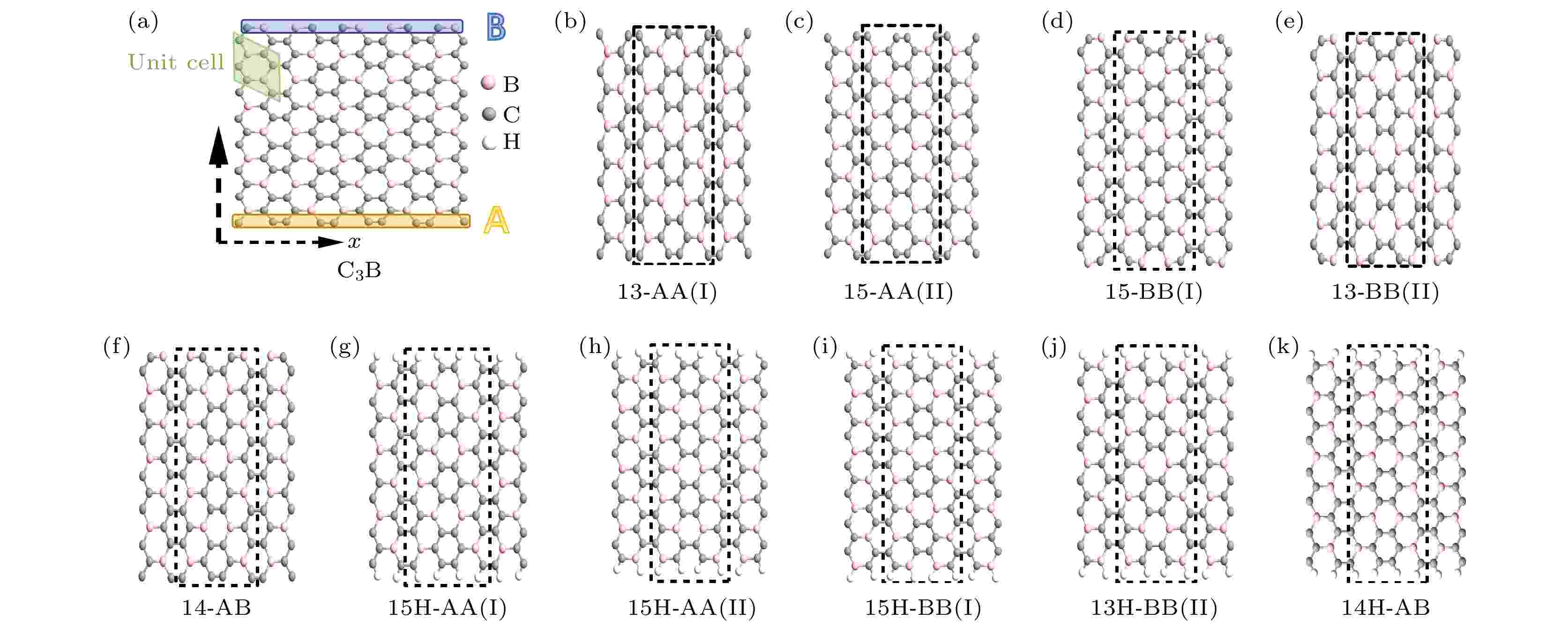
2023, 72 (11): 117101.
doi:10.7498/aps.72.20222434
Abstract +
C3B monolayer is a typical graphene-like two-dimensional material, which has been successfully prepared experimentally. Here, we use the density functional theory to study the structural stability, electronic properties and physical regulation effects of its armchair-edged nanoribbons. The results show that for the bare-edged nanoribbons, if the ribbon edges are composed of C atoms completely (AA-type), their electronic phase is a semiconductor; when both ribbons edges consist of C and B atoms (BB-type) jointly, their electronic phase is a metal; if one edge of the ribbon is composed of C atoms and the other edge is comprised of B and C atoms (AB-type), their electronic phase is also a metal. This suggests that the B atom located at the ribbon edge plays an important role in determining whether nanoribbons is a metal or semiconductor. While for the H-terminated nanoribbons, they are all direct or indirect band-gap semiconductors. The carrier mobility of H-terminated nanoribbons is generally lower than that of bare-edged nanoribbon, which is closely related to their larger effective mass and higher deformation potential values. Meanwhile, it is found that the semiconducting nanoribbons are very sensitive to physical regulation, especially under applied compressive strain and external electric field, the band gap of the nanoribbons becomes very smaller, which is favorable for the absorption of light energy and development of novel optical devices.
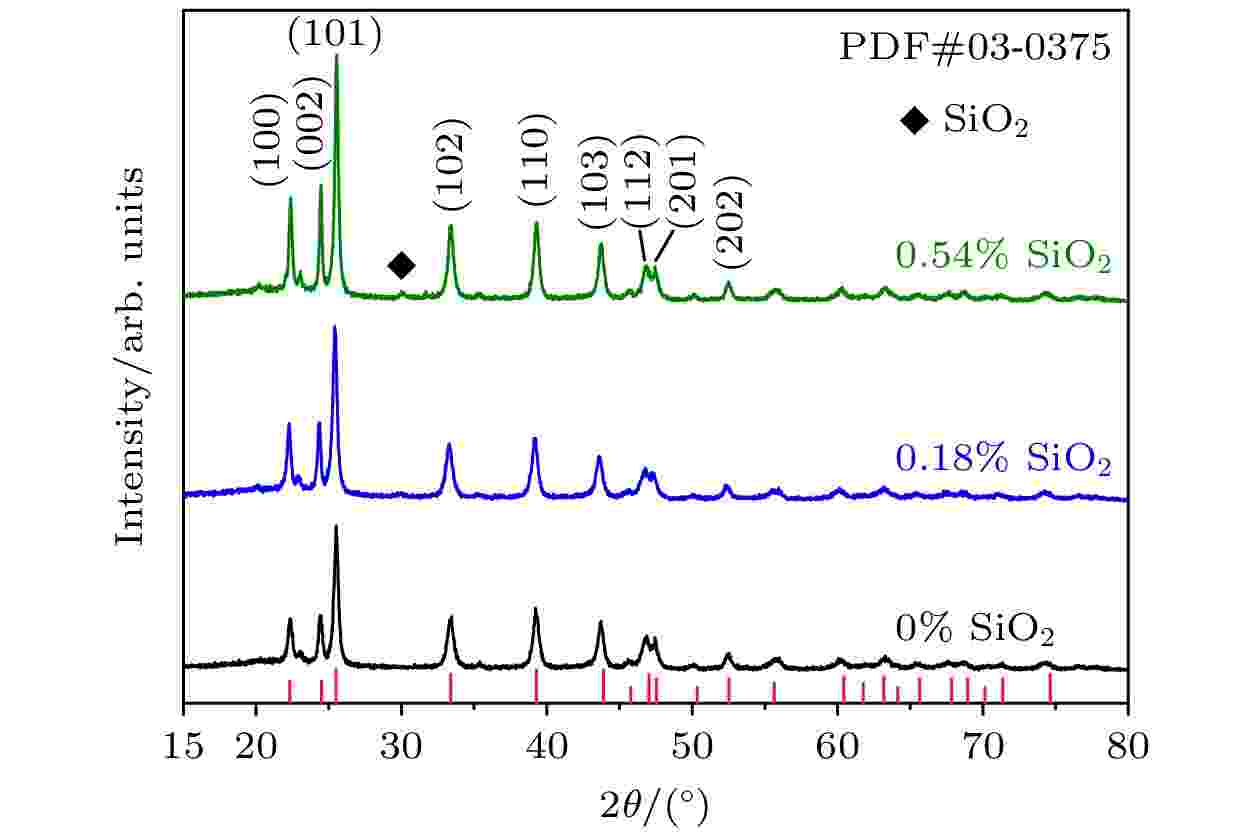
2023, 72 (11): 117102.
doi:10.7498/aps.72.20230176
Abstract +
Recently, Mg3(Sb,Bi)2-based thermoelectric materials have received extensive attention owing to excellent thermoelectric properties and the low cost. This study investigates the change and mechanism of thermoelectric transport properties of Mg3.275Mn0.025Sb1.49Bi0.5Te0.01/SiO2nanocomposite. The results show that nano-SiO2can effectively scatter phonons, promote the reduction of lattice thermal conductivity, and optimize the heat transport performance owing to the introduction of a large number of tiny grain boundaries. For example, when SiO2content is 0.54%, the thermal conductivity decreases by 15% from 1.24 W/(m·K) to 1.04 W/(m·K) compared with that of 0% SiO2sample at room temperature. At the same time, the material system also has a strong scattering effect on electrons. This leads to a sharp attenuation of power factor and electrical transport performance with decline of mobility and conductivity in the room temperature area. Nano SiO2is an effective candidate for regulating thermoelectric properties of Mg3Sb2based thermoelectric material. The thermoelectric transport performance of the material will be improved by combining with other methods, such as appropriate grain boundary modification to reduce the potential barrier of charge carrier transport.
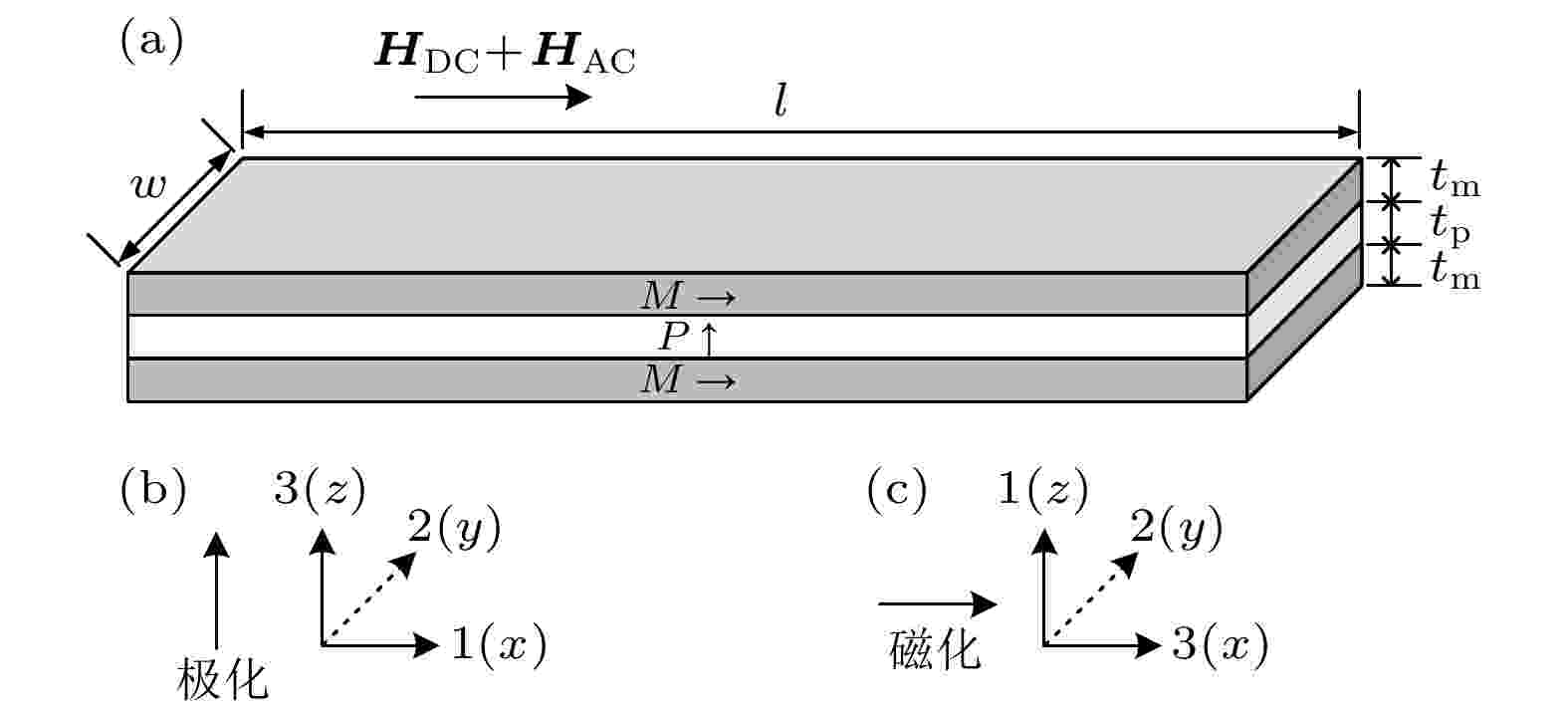
2023, 72 (11): 117501.
doi:10.7498/aps.72.20222277
Abstract +
Magnetoelectric composites comprised of piezoelectric and magnetostrictive materials, are widely used in magnetic field sensing, energy harvesting, and transducers. This work establishes a finite element model of a laminated magnetoelectric transducer coupled with magneto-elastic-electric fields based on the constitutive equation of the nonlinear magnetostrictive material. Then, the resonant magnetoelectric effect under different biased magnetic fields is studied. Based on the equivalent circuit model and the two-port network theory, the magnetoelectric coefficient and the equivalent source impedance under the resonant state are completely solved for the first time. Introducing optimized L-section matching networks between the magnetoelectric transducer and the load resistor can increase the load power and expand the operating bandwidth. The simulation results are consistent with the data in the literature, thus confirming the accuracy and effectiveness of the model. The simulation results demonstrate that the magnetoelectric coefficient reaches 51.79 V/(cm·Oe) at 51.4 kHz and 450 Oe bias magnetic field, and the ultimate output power of –3.01 dBm at 50.4 kHz and 350 Oe bias magnetic field. To ensure the load power, the power increase of 2.30 dB and the bandwidth expansion of 2.27 times are achieved by optimizing the matching network. The nonlinear finite element model in this work takes into account of the magnetoelectric effect under the acoustic resonance state and quantifies the ultimate output power. The magnetoelectric transducer model can obtain high magnetoelectric coefficient, load power, and power density in a small volume, providing a significant advantage in terms of equilibrium. The research results are of great importance in guiding the design and performance improvement of miniaturized magnetically coupled wireless power transfer systems.
INTERDISCIPLINARY PHYSICS AND RELATED AREAS OF SCIENCE AND TECHNOLOGY
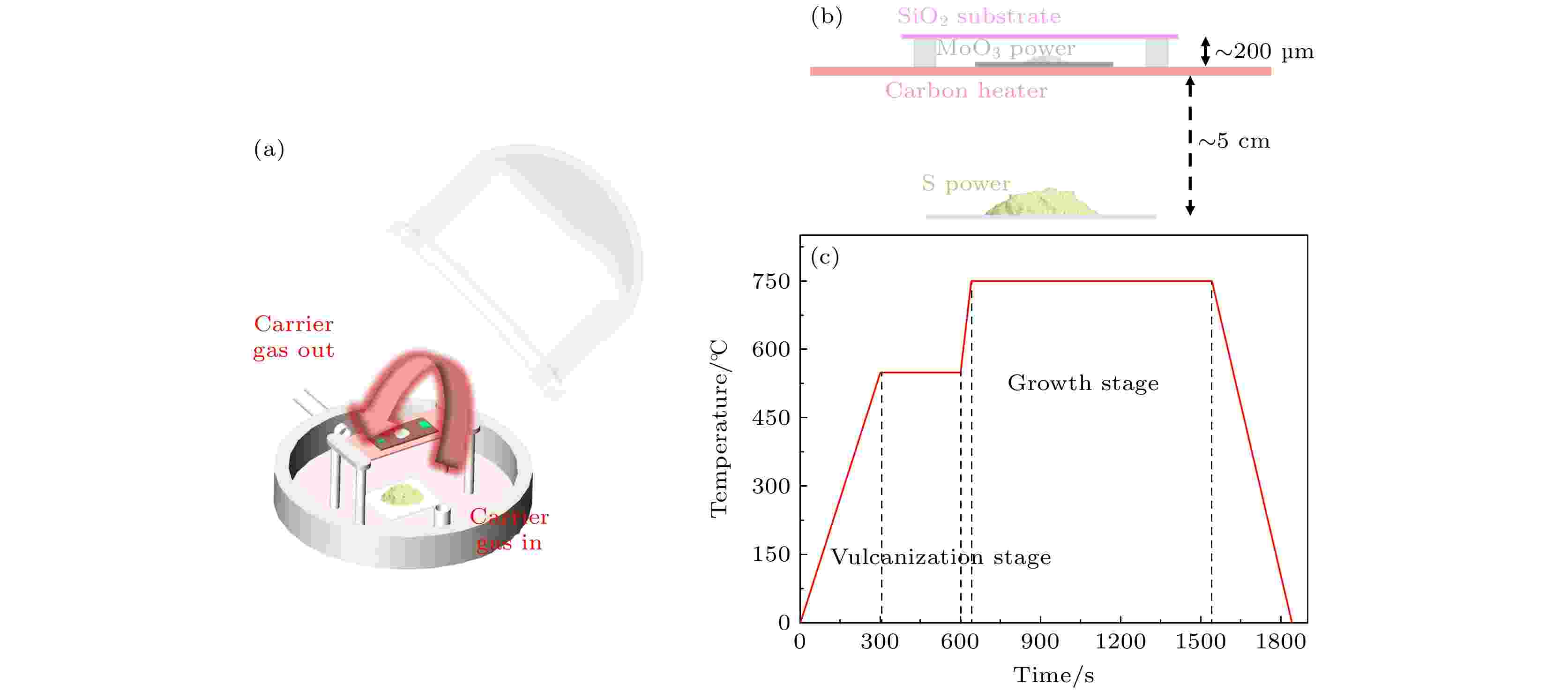
2023, 72 (11): 118101.
doi:10.7498/aps.72.20230273
Abstract +
Transition metal dichalcogenide (TMDC) monolayers exhibit enhanced electrical and optoelectrical properties, which are promising for next-generation optoelectronic devices. However, large-scale and uniform growth of TMDC monolayers with large grain size is still a considerable challenge. Presented in this work is a simple and effective approach to fabricating largescale molybdenum (MoS2) disulfide monolayers by chemical vapor deposition (CVD) method. It is found that MoS2grows from single crystal into thin film with the increase of oxide precursor proportion. The photodetector of large scale monolayer layer MoS2film is fabricated by depositing metal electrodes on the interdigital electrode mask through using thermal evaporation coating. Finally, the highly stable and repeatable photoelectric responses under the conditions of different voltages and different laser power are characterized under 405-nm laser excitation, with response time decreasing down to the order of milliseconds (ms). In addition, the photodetector achieves a wide spectral detection range from 405 nm to 830 nm, that is, from visible light to near-infrared light wavelength range, with optical response (R) of 291.7 mA/W and optical detection rate (D*) of 1.629×109Jones. The monolayer MoS2thin film photodetector demonstrated here has the advantages of low cost, feasibility of large-scale preparation, and good stability and repeatability in the wide spectrum range from visible light to near infrared light wavelength, providing the possibilities for future applications of electronic and optoelectronic devices .

2023, 72 (11): 118501.
doi:10.7498/aps.72.20230326
Abstract +
Superconducting nanowire single photon detector (SNSPD) has been widely used in quantum communication, quantum computing and other fields because of its excellent timing jitter and response speed. However, due to the mutual restraint of the technical parameters of SNSPD nanowires, there are technical challenges to further improve the comprehensive performance of SNSPD, and thus limiting its application on a large scale. Combining high detection efficiency with high timing performance is still an outstanding challenge. In this work, we report the SNSPD with 12-μm small active area, which has high speed, high efficiency, low jitter and broadband absorption. Au/SiO2membrane cavity, which is determined by finite element analysis simulation, is used to widen the optical response bandwidth. And it is easier to process and improve the alignment accuracy at the same time. The flat substrate is more conducive to the growth of superconducting thin films, so flattening process is introduced. Device package is also optimized to match smaller detector. Self-aligned packaging makes optical alignment more convenient and time-saving. Special optical fibers with small mode-field diameters can reduce the negative effect of the detector on optical coupling. The detector can achieve a maximum SDE of 82% at the central wavelength of 1310 nm and the temperature of 2.2 K, and the SDE of more than 65% in the wavelength range of 1200–1600 nm, with DCR of 70 cps. The detector also exhibits a count rate of 40 MHz@3 dB and a timing jitter of 38 ps, which is significantly improved compared with 23-μm active area detector. Furthermore, the minimum timing jitter of 22 ps can be obtained by using cryogenic amplifier readout. In this work, high comprehensive performance detector is developed, which provides an important technical reference for practical and product SNSPD.
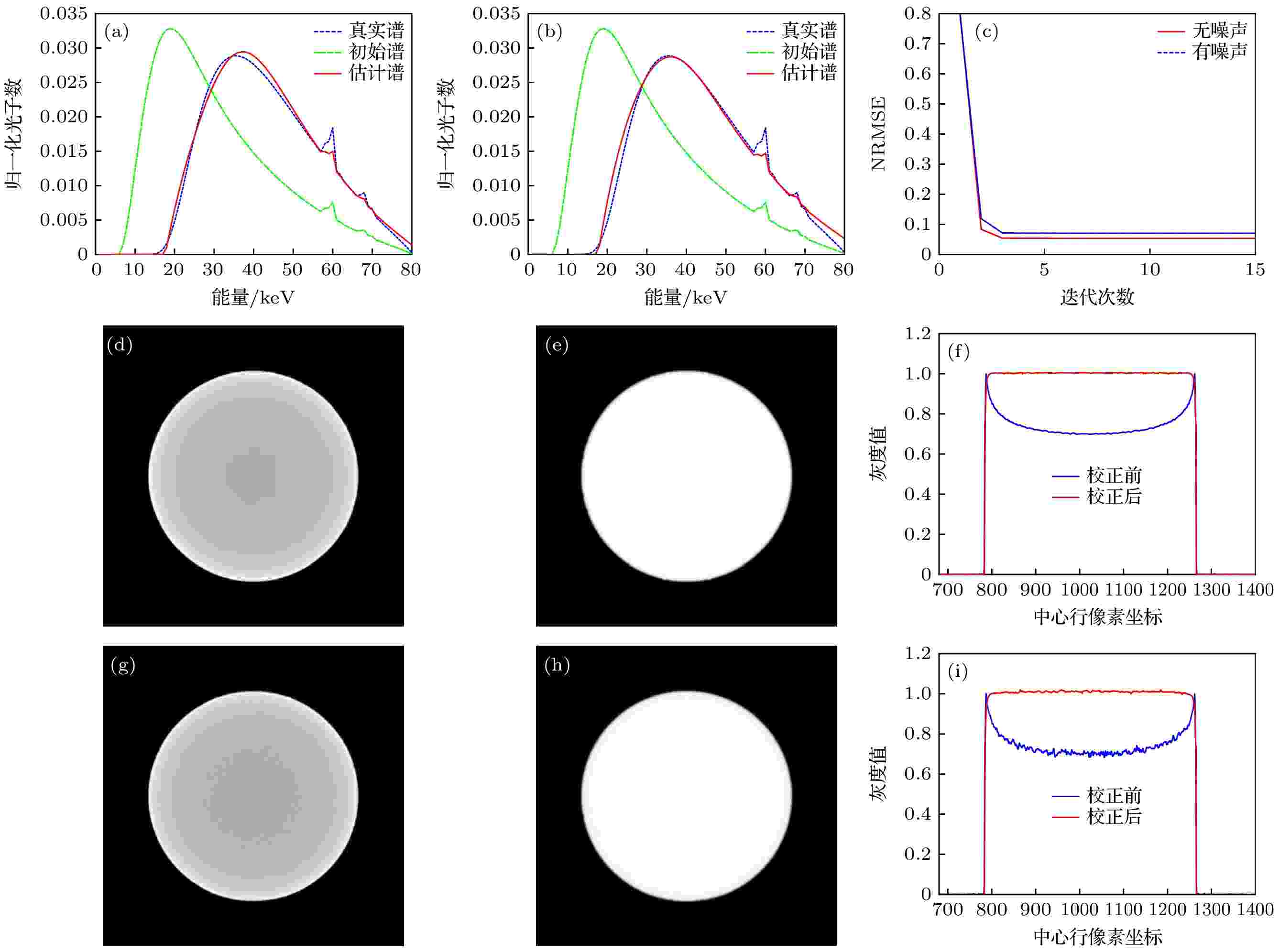
2023, 72 (11): 118701.
doi:10.7498/aps.72.20222307
Abstract +
X-ray spectrum plays an important role in computed tomography (CT) beam hardening correction, dual spectral X-ray CT imaging, and radiation dose calculation. The commonly used method to estimate X-ray spectrum is to estimate the spectra indirectly by using the attenuation data of X-ray passing through the phantoms with different thickness. Since the problem is seriously ill-conditioned, how to choose a suitable mold, establish scanning models and construct solving methods to improve the robustness and accuracy of energy spectrum estimation is the focus of this paper. In this work, in the absence scattering, we present a method to estimate the distribution of the X-ray spectrum by using CT scanning data. In this method, the mutual verification relationship between spectral estimation and image reconstruction is considered. That is, when the spectral estimation is correct, the spectral information can be used to construct a correction algorithm to remove hardening artifacts, and the image without hardening artifacts can be obtained. When the reconstructed image has no hardening artifact, it can indirectly prove that the estimated spectrum is accurate. For single-material molds, when there is no hardening artifact, CT images are fragmentation constant, which can be described by image total variation (TV) minimum. In this method, the mutual corroboration relationship is used to construct an optimization model, and then the X-ray spectrum is estimated and CT images without hardening artifacts are reconstructed through alternate iterative solutions. The characteristic of this method is that it does not necessitate obtaining the cross-line length of the measured mold with different thickness in advance, and it does not require high production precision of the said mold either. When there is a small amount of scattering in CT scanning data, the proposed method can also better estimate the energy spectrum, except for the large deviation in the high-energy part. However, as the scattering ratio increases, the high-energy portion of the energy spectrum will increase, resulting in the estimated spectrum differing greatly from the actual spectrum. Therefore, in the actual experiment, we add collimors in front of the X-ray source and detector to reduce the influence of scattering on the energy spectrum estimation. The numerical result and experimental result show that the proposed method can accurately and robustly estimate the X-ray energy spectrum.























